Working through the challenging times in Kansas City
Challenging months. That’s what two commercial real estate veterans say await the Kansas City CRE market.
Aaron Mesmer, principal with Kansas City, Missouri-based Block Real Estate Services, and Kenneth Block, principal and managing member of the firm, told Midwest Real Estate News that while the fundamentals of most commercial sectors remain strong, high interest rates and construction costs have slowed both development and sales activity in the Kansas City market.
When will development and sales activity pick up here? That depends largely on what the Federal Reserve Board does with interest rates, Block and Mesmer said.
“There has been a general slowdown in new construction because of the rising expenses of construction and the higher interest rates,” Mesmer said. “In general, there is some reluctance of buyers to make new deals until there is more certainty in the market. We have seen the number of transactions fall off from where it was a year ago.”
By Dan Rafter, Editor
This doesn’t mean that the Kansas City commercial real estate market is in freefall mode. As both Block and Mesmer say, leasing activity remains high for most sectors. And if the Fed is near the end of its interest-rate hikes? That would be good news for this market.
“We are finding our footing a bit,” Mesmer said. “There are some opportunities out there for decent deals with reasonable returns. As a company, we are trying to get projects teed up and to the starting line for development.”
Development challenges
Block said that developers today face two challenges. Construction costs have risen, with the cost of labor and materials high today.
Then there are the higher interest rates bedeviling the commercial real estate industry. It’s made developing commercial properties, whether industrial, multifamily or retail, far more expensive.
MIXED-USE
The real star in today’s commercial real estate market? Mixed-use developments
By Dan Rafter, Editor
These are challenging times in the commercial real estate industry, with high interest rates slowing both the sales of existing commercial properties and the development of new ones. That doesn’t mean, though, that all asset classes are struggling equally.
One of the more successful commercial asset types today? Mixed-use developments that

CRE MARKETPLACE PAGE 46: BROKERAGE FIRMS DEVELOPERS MULTIFAMILY FINANCE REAL ESTATE LAW FIRMS FIRMS WWW.REJOURNALS.COM VOLUME 35 ISSUE 5 SEPTEMBER 2023 MINNESOTA | MISSOURI | NEBRASKA | OHIO | TENNESSEE | WISCONSIN | THE DAKOTAS | ILLINOIS | INDIANA | IOWA | KANSAS | KENTUCKY | MICHIGAN KANSAS CITY (continued on page 14)
The CityPlace Corporate Centre III building in Overland Park, Kansas, is an example of the type of office space that continues to attract tenants
MIXED-USE (continued on page 18)





Mark Menzies menzies@rejournals.com 312-933-8559 Detroit, MI | 9th Annual December 2023 - More Detail to Come! Contact Mark Menzies Today to Speak, Sponsor or Learn More About our 2023 Michigan Real Estate Awards! COMMERCIAL REAL ESTATE SUMMIT MICHIGAN +
































Commercial Real Estate Lending Capital Markets 8 Reasons to Choose BankFinancial 's Mult ifamily Loan Program Loans of $250,000 to $3,000,000 1 Multifamily 5 Units and Above 2 LTV: Up to 65% / 80% (Dual Note) 3 Acquisition, Rate & Term, and Cash-out Refinances 4 5 3, 5, 7 & 10-year ARM Loans 6 Up to 30-year Amortizations 7 8 2nd Lien Line of Credit Loans and Investment Equity Loans Available* Capital Markets Loan Program Available Call Us Today to Discuss Your Next Commercial Real Estate Deal! 1.833.894.6999 1.833.894.6999 | BankFinancial.com All loans subject to credit and collateral approval. *BankFinancial must be the rst lien holder.
Working through the challenging times in Kansas City Challenging months lie ahead. That’s what two commercial real estate veterans say awaits the Kansas City CRE market.

The real star in today’s commercial real estate market? Mixed-use developments These are challenging times in the commercial real estate industry, with high interest rates slowing both the sales of existing commercial properties and the development of new ones. That doesn’t mean, though, that all asset classes are struggling equally.
The fundamentals are still strong: Cleveland commercial real estate market holding steady in challenging times Strong demand for multifamily properties. Demand that might even be higher for industrial. And an office sector that, while struggling, is showing signs of life. Those are the positives in today’s Cleveland-area commercial real estate market.
Not a nice-to-have but a must-have to stay in the game: Eight brownfield properties dotting Southeast Michigan might soon be home to new warehouses, distribution centers or manufacturing plants thanks to the Detroit Regional Partnership’s Verified Industrial Properties program.
Hanging tough: Kansas City’s multifamily sector shows off its resilience It’s little surprise that higher interest rates have slowed the number of multifamily sales in the Kansas City, Missouri, market. What these higher rates haven’t done, though, is slow the demand from renters for apartment space in this region.
Construction outlook: A market not for the faint of heart These are tough times for the commercial real estate construction industry, with both higher interest rates and rising materials costs making building new apartment towers, office buildings and industrial buildings more expensive. How are construction companies working through this challenging economy?
Looking for signs of a sales boost in the multifamily sector Like all commercial real estate sectors, the multifamily market has seen sales slow since the Federal Reserve Board started increasing its benchmark interest rate. But are there signs that sales activity might pick up next year? There might be.
Four words that sum up the apartment search in the Midwest? A real “suite” challenge Apartment seekers in Chicago are in for quite the challenge. But would you believe us if we said snagging a suburban rental is even harder?
Employees returning to the office?
It’s not happening yet … especially not in the United States Zoom made headlines in August when the videoconferencing company told employees who live near an office to work from that space at least two days a week.
DEPARTMENTS/COLUMNS
6 Editor’s Letter
36 The battle to bring workers back to the office: What’s the right approach?
38 PACE: The chameleon of CRE financing
39 Midwest News Briefs
43 People on the Move
46 Directory Listings
The Midwest’s commercial real publication, providing useful, unbiased and accurate coverage of the industry and its professionals since 1985.

WWW.REJOURNALS.COM
Publisher | Mark Menzies menzies@rejournals.com
Editor | Dan Rafter drafter@rejournals.com
ADVERTISING
Vice President of Sales & MW Conference Series Manager | Ernest Abood eabood@rejournals.com
Vice President of Sales | Frank E. Biondo frank.biondo@rejournals.com
Classified Director | Susan Mickey smickey@rejournals.com
Midwest Real Estate News brings real leaders together to explore the challenges and opportunities unique to their markets.
ADDRESS
1010 Lake St Suite 210, Oak Park, IL 60301 Midwest Real Estate News® (ISSN 0893-2719) is published bimonthly by Real Estate Publishing Corp., Oak Park, Il 60301 (rejournals.com). Current and back issues and additional resources, including subscription request forms and an editorial calendar, are available on the internet at rejournals.com.
4 | Midwest Real Estate News | September 2023 | www.rejournals.com
FEATURES 1 1 8 20 32 22 24 26 30
8 C M Y CM MY CY CMY K


Chicagoland’s Union Electrical Team LEARN MORE AT POWERINGCHICAGO.COM
All those COVID moves? Not all homeowners are happy where they ended up
By Dan Rafter, Editor
Remember all those people who moved during the early days of the COVID pandemic? News sites were filled with headlines of people moving from urban apartments to the suburbs. Others reported on renters finally making the move to homeownership in a bid for more space during the days when businesses were shut down and concerts and sporting events canceled.
Turns out, many of those who moved during the pandemic regret it.
A new study from All Star Home reports that one in five Americans who moved in the last three years regrets moving to a new residence or city. And many of them are already considering moving back to their former cities or neighborhoods.
That’s a lot of regrets because so many people moved during the last three years. According to All Star Home, a whopping 36% of Americans have moved during the last three years.

All Star Home surveyed 1,000 homeowners in August of 2023 about their moving habits and regrets. Survey respondents were 50% male, 49% female and 1% non-binary. Respondents ranged in age from 18 to 85, with an average age of 45.
What regrets have come with these moves? All Star Home says that nearly one out of every four people who moved to a new home since 2020 said they regret how much they paid for their new residence. They also said that they have buyers’ remorse when it comes to their new home.
Those with regrets say they are most upset about the unexpected costs of their move. Others say that they miss their old neighborhood or city or miss their old home.

Back to those unexpected costs. According to All Star Home, Americans who moved since 2020 spent an average of $4,000 on unexpected costs while making their move.
A total of 12% of the survey’s respondents said that they regret their move because of the new interest rate attached to their mortgage loan. According to All Star Home, 14% of the people who moved during the last three years have a mortgage interest rate near 7%, 17% have a 5% mortgage interest rate and 31% have an interest rate of 6%.
The survey also found that one in five survey respondents who regretted moving said that moving wasn’t worth
the hassle, while one in three said they would consider moving back to their former city or state.
But what about those Americans who haven’t moved in the last three years?
A total of 31% of respondents said they haven’t moved because they feel trapped in their current living situation because of high interest rates, while 79% said that they believe buying a home is significantly more difficult in 2023 than it has been in previous years.
Despite these hurdles, one in three survey respondents said that they plan on moving in the next three years.
Why do people want to move? According to All Star Home, the top reason is the desire for a new home. Rounding out the top reasons: Respondents wanted to move to a new city or town, wanted to move to a new state or wanted to move to live somewhere more affordable.
Midwest Real Estate News | September 2023 | www.rejournals.com 6 FROM THE EDITOR
Image provided by All Star Home.
Image provided by All Star Home.
Maintaining Skylines For Over 10 0 Years
International in 1938. As “ e Best Hands in the related damage, and deterioration to your masonry façade from store fronts to skyscrapers, historical landmarks to new construction.



Anyone Interested in Quality Workmanship

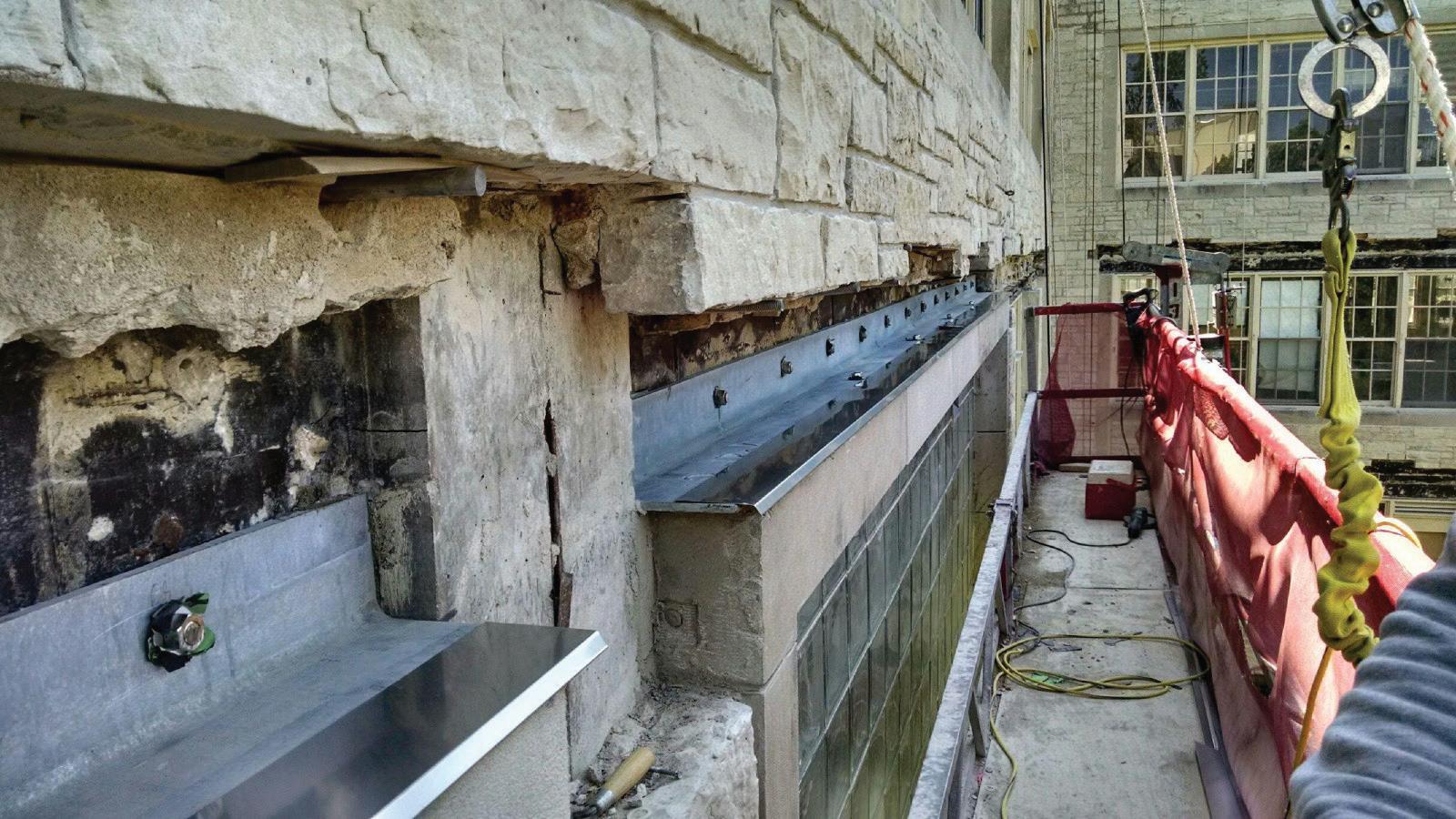



contact:











THE
PROFESSIONALS IN MASONRY RESTORATION
can
Administrative District Council #1 Call (630)
All members are medically evaluated and t tested and go thru 10 to 30 hours of OSHA training. Recognized by the City of Chicago for Sca old Training, members are also trained in Fall Protection and Silicosis Awareness. e Apprenticeship requires a minimum of 3 years training and is registered with the United States Dept of Labor. for a list of Signitory Contractors Websites: tuckpointers.weebly.com www.bacadc1.org Ad paid for by Tuckpointers Promotional Fund
941-2300
POINTER, CLEANER & CAULKER
The fundamentals are still strong: Cleveland commercial real estate market holding steady in challenging times
 By Dan Rafter, Editor
By Dan Rafter, Editor
Strong demand for multifamily properties. Demand that might even be higher for industrial. And an office sector that, while struggling, is showing signs of life. Those are the positives in today’s Cleveland-area commercial real estate market.
What’s behind Cleveland’s solid performance? We spoke with Grant Fitzgerald, vice president and regional manager for the Cleveland and Colum-
bus regions with Marcus & Millichap. Here is some of what he had to say about the resilience of Cleveland’s CRE market.
Let’s start with the multifamily sector. Have higher interest rates slowed multifamily sales in the Cleveland market?
Grant Fitzgerald: Historical context is important. Transactionally, we are down from the last two years in multi-
family sales. But those years were such anomalies for everyone in every market. Historically, transaction volume in the multifamily sector today is consistent with what it usually has been. I’d say that things are going well in the apartment business. Yes, we are down in multifamily transactions from last year, as is everybody. But historically, we are above our average.
I assume that leasing activity in multifamily remains strong, though, right?
Fitzgerald: Vacancies and rental rates are both holding strong. I think our vacancy rate might be up slightly from the last couple of years, but historically these vacancy rates are low. According to our research department, Cleveland has the second-lowest multifamily vacancy rate among the major Midwest markets.
Why are apartment vacancy rates so low in the Cleveland market?
Photo by DJ Johnson via unsplash
Fitzgerald: Stability is the key. Cleveland’s pipeline of new apartment units is relatively low by any metric compared to other markets our size. That helps keep vacancies tight. But our other economic numbers are stable, too. Our employment rate and net migration rate are both stable. We never have the lowest unemployment


or lowest amount of net migration in the country. But we are never in a bad spot with those numbers, either. We have a stable population, employment situation and housing supply. That’s a good recipe for having people stay put. It’s a good recipe for keeping renters here.
There is an interesting trend happening in the multifamily sector here. Sometimes, the rents for Class-A apartment units are higher than your average mortgage payment here. With how tight the housing market is today, with such a low inventory of homes for sale, that is helping those Class-A properties, making them
COMPREHENSIVE LEGAL SERVICES

To assist buyers, sellers, landlords or tenants involved with retail, office, commercial, industrial, multi-family, residential or vacant real estate.
ACQUISITIONS, DISPOSITIONS & DEVELOPMENT
CLASS ACTIONS
CORPORATE TRANSACTIONS
EMINENT DOMAIN
FINANCE
INSURANCE RECOVERY
JOINT VENTURES & ENTITY FORMATION

LAND USE & ZONING
LEASING
LITIGATION
MAJOR TITLE & ESCROW CLAIMS
REGULATORY COMPLIANCE
SUBDIVISION PLATTING
ZONING, LAND USE & PERMITTING
more attractive. Class-C and Class-B apartment leasing activity is always strong here. Today, Class-A rentals are strong, too, thanks in part because the single-family housing market is so tight.
www.rejournals.com | September 2023 | Midwest Real Estate News 9 CLEVELAND
CLEVELAND | COLUMBUS | CHICAGO | FORT MYERS | NAPLES | SAN DIEGO AARON S. EVENCHIK Chair, Real Estate Practice Group aevenchik@hahnlaw.com | 216.274.2450 HAHN LOESER & PARKS LLP | HAHNLAW.COM | 216.621.0150 200 PUBLIC SQUARE | SUITE 2800 | CLEVELAND, OH 44114
CLEVELAND (continued on page 10)
Grant Fitzgerald
“Historically, transaction volume in the multifamily sector today is consistent with what it usually has been. I’d say that things are going well in the apartment business.”
How about industrial leasing activity? Is that strong today, too, in the Cleveland area?




Fitzgerald: It is healthy. That is true of most markets. I’d say that the construction of new industrial properties is down from the last couple of years but up when you look at our market historically. Vacancies are more or less flat, but they are very low. The Columbus market has seen a greater number of noteworthy industrial projects and companies moving to its area. But Columbus is close enough to Cleveland that the activity there is having a positive impact on Cleveland in terms of logistics hubs and warehouses needed. For the state of Ohio in general, the activity in Columbus has been a huge positive.

And despite the challenges of the economy, it doesn’t look like industrial leasing activity will be slowing any time soon.
Fitzgerald: I wouldn’t think so. This trend is not new, but retailers have been downsizing their footprints. The big-box
stores of the 1990s and early 2000s are becoming rarer. The same thing is happening with big indoor shopping malls. Retailers are sacrificing physical space and replacing it with distribution cen-


ters. That is a trend that is here to stay. I don’t see the gigantic Best Buys or Circuit City stores coming back in the way they were. That increase in the demand for warehouse space is not going away.
Just look outside your window and see how many Amazon trucks go buy. The same thing is happening in Cleveland that is happening across the country.
Midwest Real Estate News | September 2023 | www.rejournals.com 10
CLEVELAND (continued from page 9) CLEVELAND MIKE FURLONG, CM-BIM Managing Principal 330.414.9970 | mike.furlong@ipsvdc.com | www.ipsvdc.com • BIM Coordination Services • Site Logistics • 3D Content Creation • Revit® • Navisworks® • 3D Studio Max • Residential Design Integrated Project Solutions We protect your future project investments through BIM/VDC to improve construction coordination schedule, reduce unexpected challenges & improve your BOTTOM LINE!
Photo by Steve Dimatteo via unsplash
transaction volume would be down this year even without the higher interest rates, considering how much activity the market saw in 2021 and 2022?






Fitzgerald: Maybe not. I agree that it is inevitable that sales activity would have slowed at some time. You can’t have bull runs of transactional velocity forever. That’s not possible. The interest rates caused the change, but the change was inevitable.
There is a crop of people every year in every market who must sell for a variety of personal or business reasons. We had such a disproportionate number of those people trade in the last twoand-a-half years that the people who might have fallen into that category this year might have already completed their sales. They might have been off the table already. Of course, the higher interest rates haven’t helped. They created a gap between buyers and sellers. That is the domino that fell that put a halt on the high transaction
www.rejournals.com | September 2023 | Midwest Real Estate News 11 CLEVELAND
What about industrial sales activity? type in which sales activity is down anomalies. We are coming down off
Independently Owned and Operated / A Member of the Cushman & Wakefield Alliance Cushman & Wakefield Copyright 2023. No warranty or representation, express or implied, is made to the accuracy or completeness of the information contained herein, and same is submitted subject to errors, omissions, change of price, rental or other conditions, withdrawal without notice, and to any special listing conditions imposed by the property owner(s). As applicable, we make no representation as to the condition of the property (or properties) in question. 6100 Rockside Woods Blvd, Suite 200, Cleveland, Ohio 44131 +1 216 520 1200 • www.crescorealestate.com 799 E. 73RD STREET CLEVELAND, OHIO 44103 FOR SALE: 445,682 SF multi-tenant industrial complex on 27.44 AC, located in “Oppurtunity Zone” ELIOT KIJEWSKI, SIOR 202 MONTROSE WEST COPLEY, OHIO 44321 FOR LEASE: Several suites of varying sizes, proximate to the most substantial commercial corridor in the area BILL STEVENS 1277 WEST 6TH STREET CLEVELAND, OHIO 44113 FOR LEASE: 4,300 SF future restaurant space in the heart of Downtown Cleveland’s Warehouse District RYAN FISHER
CLEVELAND (continued on page 12)
Photo by Leo via unsplash
Would stability regarding interest rates help increase sales volume in the market?
Fitzgerald: It would help. It already has to some extent. There was a tremendous amount of uncertainty that really halted sales. There is already some stability again, though, that has encouraged people to get
transacting again or seriously consider it. I would anticipate next year that we will see an increase in sales velocity. We will see a more normal year. There was some delusion that these rates would come back down. That’s not logical, but some people thought it. Now that they haven’t, people are settling into it. I don’t expect to see a boom in sales activity, but I do expect next year to be an improvement on this year. It should be a more normal, average year.
Office markets have struggled across the country. Are you seeing any positives signs, though, in the Cleveland-area office sector?
Fitzgerald: Entering April, Cleveland had the fourth-lowest office vacancy rate among major U.S. markets for office. That is great. We are not building a lot of new office space, so vacancies remain reasonable. The office market here is certainly not booming, but the stability is a good sign.
We are seeing a shift in the office sector. It’s not bad or good. We are seeing it with large companies. Companies are reimagining what their headquarters spaces need to offer. It could be downsizing, or it could be a larger, more experiential footprint. The old office of 1980 to 2005 is just not cutting it for a lot of companies, not the way in which they are designed, positioned or located. Some companies are looking to move to a suburban location.

Others are seeing opportunities to get higher-quality space in the CBD. It will be a couple of years before we know what this new office market will look like.
The office sector seems to be doing OK in Cleveland, though. There is a lot of willingness from lenders to work with borrowers, something that did not happen in the Great Financial Crisis. Everyone knows that the office sector is struggling. Instead of lenders trying to do a ‘gotcha’ and take back properties, they are working with borrowers to make it a smoother process for everyone. That has allowed some breathing space in the market. That’s been a bright spot.
What about converting old office space to multifamily? Are you seeing that taking place in Cleveland?
Fitzgerald? I think the office conversion idea is much more challenging economically to implement than people think. It’s a nice idea, but when you look at the deals, nine out of 10 don’t come close to penciling out. We might see a little bit of conversion activity, but not as much as we are reading about it in the news. I don’t think it is as viable as some of the stories make it out to be.

Midwest Real Estate News | September 2023 | www.rejournals.com 12
CLEVELAND BUILDING COMMUNITY THROUGH MISSION DRIVEN CONSTRUCTION SINCE
www.amhigley.com
CLEVELAND (continued from page 11)
1925
CLEVELAND | DETROIT | PITTSBURGH | AKRON
“Entering April, Cleveland had the fourth-lowest office vacancy rate among major U.S. markets for office. That is great. We are not building a lot of new office space, so vacancies remain reasonable. The office market here is certainly not booming, but the stability is a good sign..”




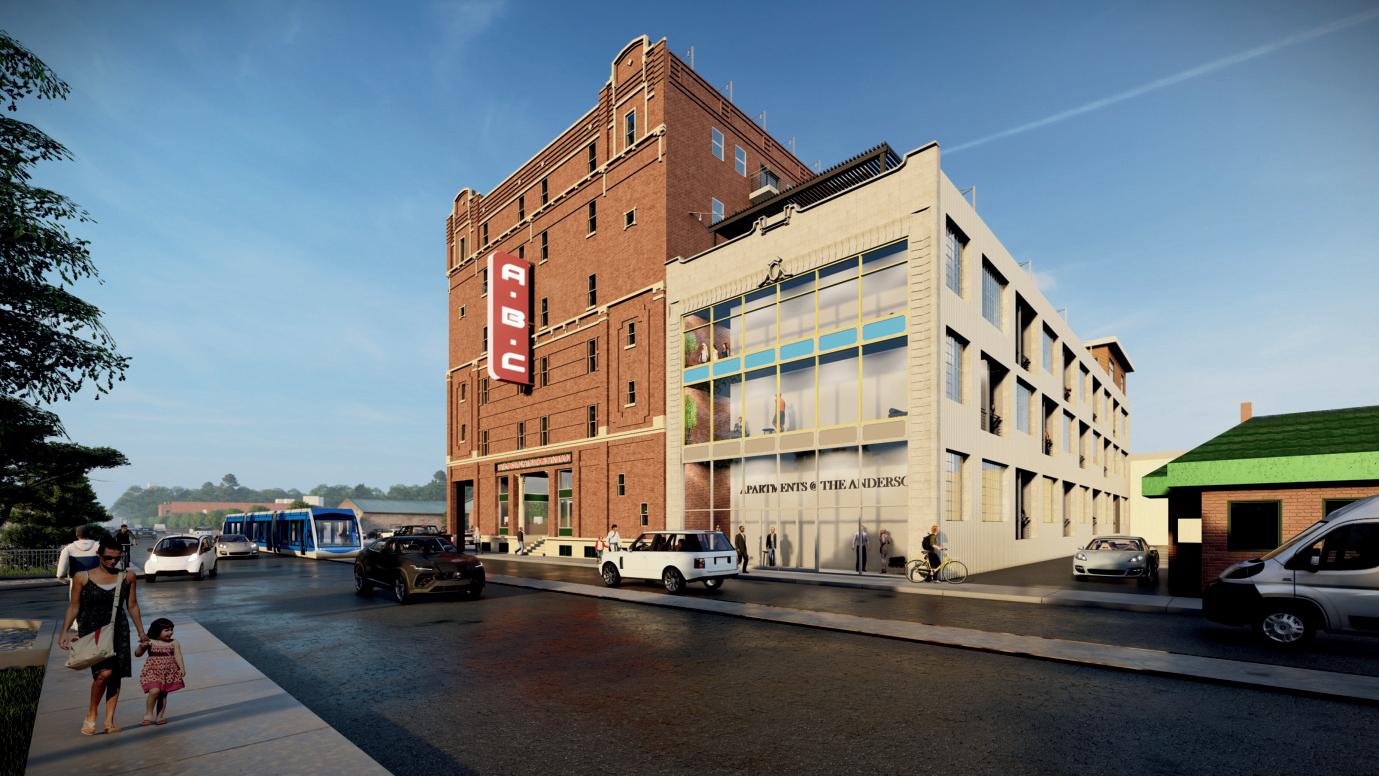

First in Historic Renovation & Urban Infill byexact@brickkc.com 3829 Main Street Ste 103 Kansas City Missouri 64111 exactarchitects.com exact architects architecture services tax credit investments development consultation harvey dutton building Garment District Fully Capitalized 10th & walnut Downtown Core Seeking Investors the aines dairy Martini Corner Opening Spring 2024 anderson & abc Main Street Midtown 75% Capitalized Seeking Investors
“Team up inflation with higher interest rates, and it’s basically made doing projects really not that smart today,” Block said. “You can’t track where your costs are going when rates are rising. We’d get a price and then three weeks later, we’d get a new price. Because of this, we stopped all new projects this year.”
The good news? Most analysts are predicting that the Fed is at least near the top of where it will push its benchmark interest rate. There might be one or two more rate increases, but these won’t be major bumps.
And while Block is waiting for rate stability, the company is doing everything it can to get its projects ready to go. That way, when rates do settle and stability returns to the market, Block can jump quickly back to development work.
A sales slowdown
As in other markets, commercial real estate sales have slowed in the Kansas City region. That’s to be expected: Higher interest rates have convinced many sellers to hold onto their properties. And buyers aren’t happy with the prices that sellers are attaching to their commercial buildings.
“There was a lot of profit-making over the last several years,” Mesmer said. “There were many scenarios in which the sellers would sell but only if they could get a crazy number. They were getting that crazier number more often than you’d think.”
As Mesmer says, transaction volumes were higher than normal before interest rates began rising. They have been lower than normal for the last year. Mesmer predicts that transaction volume should normalize as interest rates stabilize.
This doesn’t mean that sales volumes will be as high as they were before the Fed began its series of rate hikes. Again, sales activity before the Fed’s moves was abnormally high. It won’t be easy for sales volume to match those highs.
“I don’t think anyone is saying that the Fed will raise rates another 400 basis points,” Mesmer said. “You can decide whether the Fed might raise its rate by 25 basis points or maybe another 50. But you won’t see that big increase again. When we see that stability, I think you’ll see more sellers willing to sell. For now, though, many are sitting on their properties and waiting to see what might happen.”
Some commercial sales will be forced by the structure of loan deals that were completed two or three years ago.
As Mesmer says, the first of these big financing resets will happen in the third quarter of this year.
“The fundamentals are still good for most commercial real estate types, except for office,” Mesmer said. “Multifamily rents have gone up. Industrial rents have gone up. But when the interest rate goes from 3.5% to 6.5%, does that cause an issue with the lender? Or does it mean staying involved in a property and devoting much of what was once cash flow to debt? This will play out during the next six to 12 months. In some cases, the borrowers are strong and will have the capital to put more money in. In others, the borrowers will be kicked off the horse.”
An office bright spot
The office sector is struggling in the Kansas City market, much like it is across the country. But Block pointed to one strength of this sector: office space located in mixed-use developments.
Block said that mixed-use developments remain in demand. And that includes office space located in them.
“Office in true, modern mixed-use developments, with restaurants, retail and living accommodations, is performing well,” Block said. “The rents are strong for these spaces, and so is

the demand. There is an interesting break with the haves and have-nots. The Class-B and C-plus office spaces are struggling quite a bit. Tenants don’t want to go into those spaces.”
Many of Kansas City’s older office buildings have been targeted for redevelopment, Block said, with many slated to become multifamily space or hotels.
Some of this has already happened in downtown Kansas City, Block said. Construction crews have transformed much of the class-C office space in the center of the city into apartment buildings or new hotels.
This has had a positive impact on Kansas City’s downtown, with Block saying that these repurposed projects have helped push down the office vacancy rate in the city’s urban core.
The challenge? Not all Class-C and -B office buildings can be converted affordably to other uses.
“Does the building work for that renovation?” Block asked. “You have to look at how the building is sized. You have to look at its core and the distance from the core to its outside walls to make sure it’s a good fit for residential units. Some buildings don’t fit correctly. They have too much core area, too much wasted space.
KANSAS CITY (continued from page 1)
Block Real Estate Services’ Residences at Galleria in Overland Park, Kansas.
“Some of these buildings are in the right locations, but some are in the wrong locations. Those that are in the wrong locations will be removed and some new product will be built. Those in the right locations are going to be repositioned if the economics make sense.”
Suburban office spaces with their large parking lots provide enticing development opportunities, too, Mesmer said.

With more people working from home, suburban office parks that once needed four parking spots for every 1,000 square feet might now need one-anda-quarter to one-and-a-half spots for the same amount of office space. This means that a portion of their parking lots can be used to house new developments.
Mesmer points to a suburban office development in Overland Park, Kansas. This building boasts a large parking lot. But because it no longer needs as many parking spaces, the owner is turning a portion of the lot into a Dunkin’ Donuts.
The flight to quality
Block says that the flight to quality is real in the Kansas City office market. When office users do move into new space, they are increasingly leasing a
smaller amount of space. That space, though, is higher quality.
This way, office users get a better quality of space while spending about the same amount of money.
“We have been fortunate in that the buildings that we build are always ClassA-plus with first-class locations,” Block
KANSAS CITY (continued pn page 16)

www.rejournals.com | September 2023 | Midwest Real Estate News 15
KANSAS CITY “Office
modern
developments, with restaurants,
accommodations,
The rents are strong for these spaces, and
the
There is an interesting
have-nots.” 175 COMMERCE CENTRE - BLDG. 1 OLATHE, KANSAS | 1,071,139± SF AVAILABLE DELIVERING JULY 2023 FOR LEASING OPPORTUNITIES: 4622 Pennsylvania Ave Kansas City, Missouri 64112 816.756.1400 • wwww.blockllc.com IN MORE THAN 360 OFFICE, INDUSTRIAL, RETAIL, MEDICAL OFFICE, AND MULTIFAMILY DEVELOPMENTS OF RETAIL, OFFICE AND INDUSTRIAL PROPERTIES UNDER MANAGEMENT OVER 45
in true,
mixed-use
retail and living
is performing well.
so is
demand.
break with the haves and
said. “We have attracted a great group of tenants to our office space. The quality of the space and the amenities a space offers are so important. What you must do to attract workers today is different than what you had to do 10, 15 or 20 years ago.”
The office sector remains in limbo largely because so many employees are still working from home. Some major companies are now requiring that their workers return to the office, at least on a hybrid basis.
But these moves have yet to result in a lower vacancy rate or more activity in the office sector.
Block, though, said that this will gradually change as more workers return to the office.
“Employers are finding that they are not getting the level of quality work out of employees when they are not in the office,” Block said. “They are not getting the synergy between employees. And don’t forget, part of the payment that
employers make to their employees is for their commute to the office. That has been figured into the employees’ pay. If employees are not commuting, the employer might say it needs to pay them less. They are not spending the time or money or gas to commute into work. That is starting to happen now. It is a very fluid office market today.”
The fundamental strength of other sectors
While the office sector continues to
struggle, other commercial sectors remain solid, such as multifamily and industrial.
Demand remains high for apartment and industrial space throughout the Kansas City region and the entire country.
Mesmer, though, said that he has seen a slowdown in rent growth in some multifamily markets. Fortunately, the Kansas City market has bucked that trend, he said.
“Kansas City developers were more reluctant to build a lot of product at once,” Mesmer said. “We have had fewer units delivered relative to our peer cities. Our rent growth is strong because of this lack of supply. In other markets, we are seeing a slowdown in rent growth. And that slowdown does have an impact on the number of transactions in this sector.”
The underlying fundamentals of the multifamily market remain strong, though, Mesmer said. That’s largely because the country is still undersupplied when it comes to housing.
“We think that the multifamily fundamentals will remain strong for some time,” Mesmer said.


The commercial industrial market has remained strong for several years, too. Demand remains exceedingly high for industrial space throughout the Kansas City market, Block said.
That doesn’t mean that even this sector doesn’t face challenges today.
Block pointed to the high costs of construction. As he says, the cost of
Midwest Real Estate News | September 2023 | www.rejournals.com 16
KANSAS CITY (continued from page 15)
KANSAS CITY
Kenneth Block
Aaron Mesmer
building a simple industrial property has risen more than 30% during the last two years. What might have cost $60 a square foot to build now costs $80.
At the same time, interest rates that were in the low 3% range are now in the high 6% range or at 7%. That makes the cost of borrowing money higher.
This means that developers have to charge higher rents for new buildings. Blocks says that industrial buildings that might have rented for under $4 a square foot are suddenly charging $6.40 a square foot.
“In the short term, industrial development activity has slowed in our market,” Block said. “Some buildings have been completed recently. But there is not a lot of new development taking place now. There is still good activity in the smaller, light distribution market. But that product is also filling up. It’s a weird market.”
Another challenge? Many banks are
not providing the financing that developers need today, with many sitting out until the economy stabilizes, Block said.
“A lot of banks are very cautious,” Block said. “If you come in with a deal at this point, they wonder what you are doing. ‘Don’t you realize that the marketplace is terrible?’ Everybody is looking at less money today. Some of the
big commercial brokerage companies are cutting back on people right, left and in-between. If you are doing 20% or 30% less business, you are clearly in a position where you don’t have the capacity to get the income you need. You have to cut expenses.”
Again, though, that doesn’t mean that there isn’t optimism in today’s market. Just look at Block Real Estate Services.
As Ken Block says, the company has probably 20 multifamily projects that it will be ready to develop once the economy improves and interest rates stabilize.
“We want to be ready,” Block said. “But we won’t start developing these projects until the exact clear moment that the market is settling down. When that happens is unclear now.”
www.rejournals.com | September 2023 | Midwest Real Estate News 17 Contact us today for your commercial real estate mortgage banking and investment sales needs. Visit berkadia.com/kansas-city to learn more. BUILT FOR THE NOW. AND THE NEXT. ® BUILT FOR KANSAS CITY. © 2023 Berkadia Proprietary Holding LLC. Berkadia® is a trademark of Berkadia Proprietary Holding LLC. Commercial mortgage loan banking and servicing businesses are conducted exclusively by Berkadia Commercial Mortgage LLC and Berkadia Commercial Mortgage Inc. This advertisement is not intended to solicit commercial mortgage company business in Nevada. Investment sales / real estate brokerage business is conducted exclusively by Berkadia Real Estate Advisors LLC and Berkadia Real Estate Advisors Inc. Tax credit syndication business is conducted exclusively by Berkadia Affordable Tax Credit Solutions. In California, Berkadia Commercial Mortgage LLC conducts business under CA Finance Lender & Broker Lic. #988-0701, Berkadia Commercial Mortgage Inc. under CA Real Estate Broker Lic. #01874116, and Berkadia Real Estate Advisors Inc. under CA Real Estate Broker Lic. #01931050. For state licensing details for the above entities, visit www.berkadia.com/licensing 0823-432IG.. MICHAEL SPERO Senior Director Investment Sales michael.spero@berkadia.com 913.980.8698 JOHN J. SCHORGL Managing Director Mortgage Banking John.schorgl@berkadia.com 913.209.9815 NIKO VRENTAS Associate Director Investment Sales niko.vrentas@berkadia.com 913.991.0707
KANSAS CITY
“We want to be ready. But we won’t start developing these projects until the exact clear moment that the market is settling down. When that happens is unclear now..”
combine multifamily, retail, office or other property types in one building.
We spoke with Patrick Holleran, senior principal of business development, and Kent Wagster, principal, with St. Louis-based architecture firm HDA about the resilience of mixed-use developments and the reasons why these projects are often so successful.
Here is some of what they had to say. Why are mixed-use developments in such favor today? Why is demand so high for these properties on both the tenant and investor sides?

Patrick Holleran: From an investor’s standpoint, you have a broader renter base. There are multiple asset classes under one roof. It is consistent cash flow. The loss of one occupant has just a minimal impact on the revenue coming from that building. Compare that to an office tower that has a tenant taking 130,000 square feet. If that tenant leaves, the investors in that building are in big trouble. But when there is a mixture of uses, it’s a little easier to absorb the loss of one tenant.
What about from a development standpoint? What makes these properties attractive to builders and developers? And what about for tenants? What do they like about mixeduse developments?
Holleran: When you develop one of these mixed-use projects you conserve natural resources. These properties also encourage walking. Tenants will walk to a restaurant or bar in part of the development. Green space is often a part of these developments. You have outdoor spaces where renters can get some exercise and socialize. This all combines to make these projects attractive to tenants. It makes it easier to fill the spaces in these developments.
For the people who live and work in these developments, the convenience factor is huge. The last thing people want to do is get in their cars and drive five miles for something small and essential. When you can walk to get those items? It makes a difference. Even if you can’t get the item in the development in which you live, these mixed-use projects are often built in walkable communities in which you can find everything you need just a
short walk away. That makes it very convenient for the people who live, work and play in the development.
I know there is a growing demand from people for walkability.
Holleran: It’s so nice to have easy access to the things you need in your life, a coffee shop, gyms, medical clinics. A lot of developers crave these mixed-use developments that have the essentials that people need every day. It attracts people who want to live there and businesses that want to have an office there. It’s an all-around good thing.
It fosters this sense of community. If you have enough nearby amenities, you might not even need a car. Walking is good for your health. You can take the elevator down and walk to the restaurant, café or wherever you might be going.
Kent Wagster: There is the socialization aspect, too. You meet more people when you are walking instead of driving. It also creates safety. You are in what feels like a little town or village. When there are more people around, residents feel safer. There are so many people who work from home today. That’s a key factor, too. The younger
generation likes to have everything at their disposal. It’s easier to work from home when you are in a mixed-use development that gives you the opportunity to work in different places, such as a nearby coffee shop or restaurant.
What do developers need to keep in mind when creating a mixed-use development?
Holleran: To do it right, the development has to feel authentic. Developers need to be aware of where the building is and what the community needs. You can’t just build a mixed-use development on any available parcel. You have
Midwest Real Estate News | September 2023 | www.rejournals.com 18
MIXED-USE (continued from page 1) MIXED-USE
The Rail mixed-use development in St. Louis, designed by HDA.
“You meet more people when you are walking instead of driving. It also creates safety. You are in what feels like a little town or village. When there are more people around, residents feel safer.”
to do your research. What is the community lacking? What does the customer base want? The development needs to feel authentic. Research has to be done to make a mixed-used development work well.

Wagster: It’s important to remember, too, that mixed-use developments aren’t just for younger people. They serve residents of all ages. Many older people are gravitating to mixed-use developments. We see some mixeduse developments with more of a focus on senior living.
What kind of research do developers need to do to boost the odds of their mixed-use development succeeding?
Holleran: A developer should work with a consultant to do a market study. How much retail is needed in an area? What types of retail is the area lacking? How much housing is needed? How many apartment units can you put in the area? Is there the need for office space?
You can work with someone to do a market study or do it on your own. Doing that research takes time, though. You need to talk to local brokers and businesses. You need to drive the area and look at local apartment developments. What amenities do new apartment developments have? Were these new developments successful or did they miss the mark? Like anything


you do in life, it takes research. It takes working with the right professionals and taking the time to do a good job.


What kind of amenities are renters looking for today in new apartment developments?

Holleran: There has to be a good blend of indoor and outdoor amenities. People want areas for pets. They want outdoor courtyards. Some of the courtyards at new developments are unbelievable. The pools and cabanas that they feature are amazing. They might have misters spraying cool air. You almost feel like you are at a resort. It feels like you are on vacation at your own home.
The indoor amenities are equally impressive. They have workout facilities dressed to the nines. You can be a professional bodybuilder and still work out in the gyms in some of these developments. You can take yoga classes. They have additional storage areas. Some of these multifamily developments are so sophisticated that they feel like hotels, and I say that in a good way.
Wagster: They are getting very elaborate. Some feature pickleball or bocci ball courts. They might have a wide, flat area for outdoor games, movie nights or social nights. On the interior, we are also integrating some office space that tenants and residents can lease or check out. Some have theater spaces
How important is finding the right location for a mixed-use development?




Holleran: There has to be demand for a project like this. A good and experienced developer will have a very good feel for the neighborhoods in which a mixed-use development will work. A lot of them, for instance, are going up in old malls in the suburbs. Developers are buying those old malls and converting part of the space to big mixed-use developments with medical, multifamily, hospitality and office.
That’s different from what we see in urban areas. In many of the urban areas, you need to develop vertical mixed-use developments. But again, it has to be in the right location. We are seeing with all these large office towers around the country a greater opportunity to reposition these properties for a multitude of uses. We will see some of these office towers converted to mixed-use developments. But it has to be the right location and right developer.
a party room space.
www.rejournals.com | September 2023 | Midwest Real Estate News 19
that can double as an interior movie night area or
MIXED-USE
Please contact us for any upcoming project needs! 847.374.9200 · www.meridiandb.com DESIGN BUILD · GENERAL CONTRACTING CONSTRUCTION MANAGEMENT UNDER CONSTRUCTION... Ask us how we can help you incorporate sustainability into your next project! Think of us for your next Indianapolis area project... ARCHITECT: Curran Architecture CIVIL ENGINEER: Kimley-Horn Hobbs Station - Buildings 1 & 2 Plainfield, IN - 233,618 & 263,922 SF
HDA-designed Two Twelve Clayton, a multifamily development in Clayton, Missouri, with a pizza restaurant on its bottom floor.
Not a nice-to-have but a must-have to stay in the game: Detroit Regional Partnership program makes it easy for companies to find available land in Southeast Michigan
By Dan Rafter, Editor
Eight brownfield properties dotting Southeast Michigan might soon be home to new warehouses, distribution centers or manufacturing plants thanks to the Detroit Regional Partnership’s Verified Industrial Properties program.
The goal of this program, better known by its acronym of VIP by DRP, is to boost the site-readiness of brownfields throughout Southeast Michigan. The

program, which launched in October of last year, offers incentives to encourage partners to submit available properties to an online portal.
Developers can then search the portal to find sites that fit their needs.
That portal, www.verifiedindustrialproperties.com, is a key to the program: It highlights former brownfield sites that have been vetted for environmental, zoning and other develop-
ment-readiness factors. Third-party engineers verify the condition of vacant industrial parcels of 10 acres or more by evaluating how easy or difficult it would be to connect to utilities, whether wetlands mark the site, if there are easements for developers to deal with and other key factors.
Examples of sites listed in the portal include the former Summit Place Mall in Waterford Township, land owned by Walbridge in Lyon Township and land
tracts that are part of the Detroit Region Aerotropolis near Detroit Metro Airport.
“We created this program with the mission of creating new jobs for our residents,” said Justin Robinson, executive vice president with the Detroit Regional Partnership. “We can create those jobs by attracting new companies to Southeast Michigan. The industrial sector is very hot right now, and the goal of the program is to en-
Midwest Real Estate News | September 2023 | www.rejournals.com 20 DETROIT
courage developers and companies to look at this part of Michigan.”
As Robinson says, the industrial vacancy rate in the Detroit region ranges from 2% to 4%, incredibly low. There are few buildings available, then, for end users.
This is causing more developers and end users to search for usable vacant land on which they can build new industrial facilities. The VIP program can help these users find such land in Southeast Michigan.
“We are stepping up and going to work on this issue,” Robinson said. “The key word is ‘proactive.’ We want to be proactive in finding ready sites for end users. We are not able to do what some areas are doing and buy land. Our objective is to make sure that we identify the strengths and weaknesses of these brownfield sites and that we list this information in our online portal. We want end users to see and understand what is out there for them in this region.”
As Shannon Selby, vice president of real estate for the Detroit Regional Partnership says, if you do nothing, you get nothing.

Selby says that verifiedindustrialproperties.com currently features information about 28 sites in the Southeast Michigan region. Visitors to the website can search by minimum acres, county, brownfield sites and greenfield sites. Each land site boasts its own engineering report and list of key data, Selby said.
The work done by the Detroit Regional Partnership’s engineering partners is key to the program’s success, Selby said. These engineers do site reporting work that takes about 10 weeks to complete. They then prepare a report on the quality, benefits and challenges of the brownfield and greenfield sites.
“We are proactively going after sites,” Selby said. “We rank these sites and prioritize those that present the most opportunity to end users. End users who are from out of the country and who don’t know Michigan can get all the information they need on the Detroit region, down to the county and down to an individual land site. There is a lot of information on the site that can really help companies make a decision on which land sites might be right for them.”
When developers and end users look for industrial sites, they often search 25 to 50 regions, Robinson said. They need information quickly, which is something the VIP’s online portal can provide.
“The reality is that these are fast-moving projects,” Robinson said. “End users aren’t calling brokers locally. They want to see the information about available land in a centralized platform so that they can compare us against Columbus, Dallas or any of the other regions that they are considering.”

Robinson said that the Detroit Re gional Partnership is working with municipalities and the owners of available land to fund the physical site studies that provide the infor mation on VIP’s web portal.

“We want to provide all the mate rials a company needs to make a decision,” Robinson said. “We want to give them the information they need to understand the status of a site.”
“Determining site readiness is a team sport,” Selby added. “It takes a collaboration of a number of us to make this happen.”
It’s also a necessity to attract com panies to the region, Selby said.
“Having a program like this isn’t something that is nice to have,” Selby said. “It’s a must-have. Site selectors need as much information as they can find. Providing that in formation to them is mandatory if we want to stay in the game.”
Like in most parts of the country, the industrial sector is performing well in the Detroit market. Not even high interest rates, which have slowed industrial sales, have slowed the demand for industrial space by end users.
It doesn’t look like the demand for warehouse, distribution and manufacturing space will slow in the region anytime soon, either.
“During the early days of the pandemic, people worried that the industrial market would dry up,” Selby said. “But it didn’t. Demand for industrial space only accelerated during COVID. People wanted their packages on their front porches. That meant that companies had a demand for even more industrial space. It’s also why we need to have land ready for these companies.”
As Selby says, Michigan is a legacy industrial state. It’s why the state has so many brownfields ready for redevelopment. And it’s why recycling these sites and putting them back into use is so important for the state.
“The industrial market might have plateaued a bit recently, but it has plateaued at some of the highest activity levels we have ever seen,” Robinson said. “The scale of the industrial projects we are seeing, the intensity of the uses, is unlike anything we’ve ever seen.”
www.rejournals.com | September 2023 | Midwest Real Estate News 21
DETROIT • Asbestos / Lead /Mold Consulting • Building & Infrastruc ture E valuations • Construction Materials Testing • Environmental Services • Geotechnical Ser vices
Indoor Air Qualit y Consulting We Provide:
•
Justin Robinson
Shannon Selby
Hanging tough: Kansas City’s multifamily sector shows off its resilience
By Dan Rafter, Editor
It’s little surprise that higher interest rates have slowed the number of multifamily sales in the Kansas City, Missouri, market. What these higher rates haven’t done, though, is slow the demand from renters for apartment space in this region.

As E.F. “Chip” Walsh, a real estate entrepreneur in the Kansas City market says, demand for apartment space is still outpacing the supply in the city and its suburban communities. And that isn’t changing anytime soon.
And Walsh has a good perspective. He is the founder and principal of Kansas City’s Mercier Street, a commercial real estate development consulting firm. He is also the founder and principal of Sustainable Development Partners, LLC, a partnership of Kansas City-based real estate professionals.
It’s safe to say, then, that Walsh knows the multifamily market in Kansas City. Here’s some of what he told us about the resilience of this sector, the demand for new apartment developments here and what might happen to all those nearly vacant office towers in the region.
Let’s start with the obvious question: Have higher interest rates slowed sales activity in the multifamily sector in the Kansas City area?
E.F. “Chip” Walsh: I am more involved in the leasing side of the market. I have a multifamily project in the construction process and two others in the early stages of development. I don’t pretend to have my pulse on the sales side of the multifamily sector. But from what I am hearing, unlike on the coasts, Kansas City seems to be doing well overall, despite the economic challenges.
That is a reflection on this market. In Kansas City, we are still seeing rent growth in the multifamily sector. We still see a strong labor market here. We have added something like 16,000 jobs in the first seven months of the year and our unemployment rate is very low. Those metrics are helping the multifamily sector.
But do I think sales volume in this sector is down year-over-year? Yes. By how much? I’m not the best person to ask about that.
How about leasing activity? Is there still strong demand from renters for apartment space in the Kansas City region?
Walsh: Yes. Leasing demand is strong. Look at the affordability gap as one key metric. What would someone pay for the average rent in an area or for the
average home mortgage? Because of where interest rates are at today, many markets still favor renting. Renting is still more affordable in many markets, including ours. At the same time, we have a shortage of units overall in the Kansas City metropolitan area. This shortage is most acute in what would be called the affordable or workforce housing areas. We are doing just fine with luxury, but we need more workforce multifamily.
Those higher mortgage interest rates and our lack of enough supply are both positives for rent growth. They are also positives for leasing activity. Is our multifamily vacancy rate up? Yes, slightly. But overall, this market is performing well.
Are you seeing developers bringing new apartment units to the Kansas City area, helping to lessen that supply shortage?
Midwest Real Estate News | September 2023 | www.rejournals.com 22
KANSAS
CITY
The Cordish Companies’ Three Light Luxury Apartments recently opened in Kansas City’s Power & Light District.
KANSAS CITY












Walsh: We’re looking at a bi-state area here, Missouri and Kansas. This market includes two states, five counties and a lot of municipalities. Overall, I’d say there is good demand for new apartment units throughout the region and there is new product in the pipeline. If you look at the market on a year-over-year basis, though, it would not surprise me if the volume of new supply was down a bit.
The activity in Kansas City, Missouri, proper is a little more exciting. In the CBD we had a project for a new office tower near our T-Mobile Center. Earlier this summer, the developers repositioned it for multifamily. I do expect to see more of that as office space continues to go unused.
Do you expect to see more office space converted into multifamily?
Walsh: Right now, our CBD has a vacancy rate of about 25% in the office sector. And market wide, the most recent data for larger office buildings also showed a high vacancy rate in the second quarter. The owners of some of these office properties are going
to have to find ways to do conversions. Maybe they can use historic tax credits or some other type of financial incentive. Many of these conversions will require some sort of financial incentive.
These conversions can be expensive, though. Are there some buildings where converting from office to multifamily won’t make financial sense?

Walsh: That depends on so many factors. I had a deal five years ago where the office floorplates worked out well. How the office property was laid out made sense for a conversion. You do have to look at the key factors: How much of an open floor plan do you have once you take out the dividing walls? Where is the central core? When was the office building originally built? But there are some good opportunities in this market to convert office buildings to apartments. That’s why you have seen strong demand for this type of conversion in multiple markets.
Now that the pandemic seems mostly behind us, are you seeing people


























returning to downtown Kansas City? Do people still want to live in the city’s urban core?



Walsh: Our urban core is still a desirable location for a renter. We are seeing that submarket come back. The office market in our urban core, though, is still lagging. We are seeing a lot of companies moving from existing space to a smaller office footprint. That is adding pressure to the upward vacancy rate we are seeing in the office sector downtown.
I think going forward, though, you will continue to see people wanting to live in downtown Kansas City. The Cordish Companies recently opened its Three Light Luxury Apartments in our Power & Light District. This comes on the heels of the company’s One Light and Two Light apartment developments. To me, that is another sign that our urban core is still desirable for renters.
There is also some talk that one of our professional sports teams, the Kansas City Royals, might relocate. One possible landing spot would be the central business district. They

are proposing a village concept with a mixed-use development adjacent to the new stadium, one that might include office and residential. That would be another boost to our urban core.
When it comes to amenities, what are renters looking for in new properties?
Walsh: There is an escalation war with amenities. If a property has something new, the next property has to match it and the next property has to go above and beyond. The days of having just a pool and community room are over. The amenities are not just for the people living in the buildings, either. They are for their pets. It’s important today to have properties that are dog-friendly. You see amenities such as cat- and dog-washing stations and on-site dog parks. Some properties offer dog-walking services. It really is a big change from what it used to be.
www.rejournals.com | September 2023 | Midwest Real Estate News 23
No longer run-and-gun: Dealing with a normalizing commercial construction industry
By Dan Rafter, Editor
Hurdles? Commercial construction companies face plenty today. The cost of construction materials continues to rise. Labor is more expensive and difficult to find. Then there are the high interest rates that have slowed sales and development activity across the commercial real estate business.
It’s combined to make navigating the business a true challenge today for commercial construction professionals.
But the good news? There is hope. The Federal Reserve Board has signaled that its interest-rate tweaks might be nearing their end. The price of materials isn’t rising as quickly as it once was, at least for some components. And the wait times for construction materials are finally starting to ease.
The big hope is that economic stability
will return to the country and industry sometime next year, and that this will make life easier for commercial construction companies.
“Yes, these are challenging times,” said David Julian, vice president of business development with Oak Brook, Illinois-based Krusinski Construction Company. “But the bigger and broader answer is that deals are still getting done. Buildings are still getting built. It’s much more challenging today, especially from the capital investments side. But there is still construction activity.”
Not all commercial properties are created equal, though. Julian said that certain property types are more difficult to build today.
He points to his experience at the I.Con Cold Storage 2023 conference recently held in Atlanta. Those participating in the conference said that it’s espe-
cially difficult to build spec properties today. Getting the financing for these projects is a hurdle that is too difficult for many deals to overcome.
But it’s far easier to qualify for financing and complete build-to-suit projects, Julian said.

“Those build-to-suit projects are still challenging because of rising interest rates and escalating costs for materials, but those deals are less cumbersome than the spec projects,” he said. “It’s one of those things: We were going 150 miles an hour when it came to construction activity. Now we are going 100 miles an hour. We are not going as fast, but we are still going 100 miles an hour.”
That brings up the big question: Would commercial construction activity have slowed this year – or maybe next –even if interest rates didn’t increase so dramatically?
Maybe, Julian said.
“I think normalizing is a good way to describe this market,” Julian said. “You can only sustain the pace we were on for so long before you run out of gas.”
Julian points to the actions of some of the larger distribution and logistics companies today. They are slowing their requests for new distribution centers and warehouses. But that doesn’t mean that these big players don’t need any new product.
“They went real fast, real fast, real fast for a long time. Now they have slowed down,” Julian said. “But they haven’t stopped completely. There are plans in place for them to approach that side of their businesses in a more strategic way. That’s normal. It’s no longer ‘runand-gun.’”
Julian said that Krusinski has seen an increase in opportunities in the manufac-
Midwest Real Estate News | September 2023 | www.rejournals.com 24
CONSTRUCTION
One of the bigger projects that Krusinski is involved in today is the consumer packaged goods (CPG) distribution center it is building for Kraft Heinz at the Chicago West Business Center in DeKalb, Illinois.
turing arena. That’s largely because of how fast technology is changing. Many of Krusinski’s manufacturing clients, those dealing in the food-and-beverage, products and services industries, need to reinvest in their technology.
These clients, then, need updated buildings and improved efficiencies with their power and waste systems.
This doesn’t mean that some projects haven’t been pushed from 2023 until next year. But there are many reasons for these changes. It’s not just because of interest rates and higher construction costs.
A land deal might have fallen through. The client might not have been able to get the land it wanted. As Julian says, it’s not always high interest rates and costs that scuttle a deal.
“There are a million-and-one reasons for a deal to die,” Julian said. “So many times, when a deal goes sideways it’s something that we haven’t seen before. We can then check that reason off the list.”
Overall, though, business is good at Krusinski. Julian says that the company celebrated its fifth-best year last year.

One of the bigger projects that Krusinski is involved in today is the consumer packaged goods (CPG) distribution center it is building for Kraft Heinz at the Chicago West Business Center in DeKalb, Illinois.
CONSTRUCTION
The project is a partnership with Krusinski, the Kraft Heinz Company and Trammell Crow Company to build one of the largest CPG distribution centers in North America. The $400 million center will cover 775,000 square feet when completed.
The new facility will feature national railway access served by Union Pacific Railroad and automation technology, including a 24/7 automated storage and retrieval system.
The project will bring 150 new jobs to the DeKalb region.
“Overall, the attitude out there is optimistic and positive,” Julian said. “It’s just a bit more challenging. When times get more challenging, you get closer to your own business, get closer to your client partners and take that ride together.”
While rising construction costs remain a challenge, there is some positives here, too. Julian said that the costs of some materials have come down, including steel, wood and timber.
“Are these costs going to get as low as they were pre-pandemic? No,” Julian said. “Again, the market is normalizing. Are these costs higher than they were? Yes. But the materials costs today are not preventing companies from building new buildings.”
There’s also some positive news surrounding interest rates. No one knows exactly what the Federal Reserve Board will do with its benchmark interest rate. But the hope is that the Fed is at least nearing the end of its rate hikes.
If it is, that will bring much-needed stability to the interest-rate environment. And that, Julian said, is what developers and commercial real estate professionals are looking for.
“The good news is that even though interest rates have climbed, deals are still getting done,” Julian said. “These issues are getting worked through over time.”

www.rejournals.com | September 2023 | Midwest Real Estate News 25
David Julian
Looking for signs of a sales boost in the multifamily sector
By Dan Rafter, Editor
Like all commercial real estate sectors, the multifamily market has seen sales slow since the Federal Reserve Board started increasing its benchmark interest rate. But are there signs that sales activity might pick up next year? There might be.

We spoke with Jeremy Morton, director with Chicago-based Interra Realty, about what the second half of 2023
might hold for the multifamily sector.
Let’s start with the big question: How have higher interest rates impacted the multifamily sector?
Jeremy Morton: The interest rates have a direct effect on pricing and how buyers underwrite buildings. Sales activity has tightened. It’s more important than ever for buyers to have a good relationship with lenders, whether
those lenders are local or national.
I did a handful of valuations in the spring in which interest rates were almost a point lower than where they are today. Those were brought to market and we slowly saw the interest rates tick up. Obviously, that has a correlation on pricing. There is a gap between buyer values and seller expectations. That’s why multifamily sales were slower in July and early August.
From what I understand, though, you have seen signs that we might see at least a small increase in sales activity in the coming months.
Morton: It is deal-specific. But in the last few weeks, we have seen an uptick in buyers interested in seeing buildings for sale and writing offers. That also
MULTIFAMILY (continued on page 28)
Midwest Real Estate News | September 2023 | www.rejournals.com 26
MULTIFAMILY
1924 S. Throop St. in Chicago is an example of the kind of apartment unit that is attracting strong renter demand.



2023 Omaha COMMERCIAL REAL ESTATE summit November 10, 2023 Scan for more information and to register www.rejournals.com/upcomingevent/ Speaking and Sponsorship opportunities available Ernie Abood eabood@rejournals.com 773-919-8799 Embassy Suites LaVista, Omaha Hotel & Conference Center 7:45am Breakfast, Registration, and Networking 8:45am - 12:00pm Program 8th Annual
has to do with sellers correcting their expectations. We have seen a few price reductions in listings in the last month. Buyers are active. It’s all about bridging the gap on the pricing.
We are still putting deals together. But things are moving a little slower. In terms of financing, it is taking more time to get everything lined up. No one is just slamming the financing together. Everyone is spending more time and due diligence on the front end, which is the key to getting deals done.
Activity is still solid, but there is a little more hesitation, a little more going
over deals with a fine-tooth comb. Instead of touring a building and making an offer that afternoon, buyers might spend a solid week reviewing the deal with brokers and lenders, checking the numbers.
Are you seeing that gap between what buyers expect to pay and sellers want to sell for starting to tighten?
Morton: I definitely am. Previously as brokers, we could market these properties on future rental growth. We can still do that, but it has to check out on current cash flow. Six months ago, as long as buyers were breaking even on their current cash flow, that was fine. Now we need a little more cushion. Some lenders are requiring nine months of

reserves to make sure there aren’t any delinquencies.
We are trying to be more transparent with everyone today, sellers in particular. Before sellers could shoot for a higher number and hope there would be a buyer who falls in love with the building. Today, you need to be more careful on how you underwrite buildings, otherwise you’ll be left with a stagnant building that won’t sell.
In the late spring and early summer, we had honest talks with sellers to help bridge that gap.
How strong is leasing activity in that sector? Interest rates haven’t slowed leasing demand, right?
Morton: Leasing is doing well. The new-construction multifamily buildings that I have been watching have been leasing out quickly with little to no concessions. The units with a greater number of bedrooms take a little longer to lease. There’s just a smaller number of renters looking for that size of a unit. But the one-bedroom and two-bedroom units are renting quickly while rental rates have gone up a little bit. Units are not staying vacant for long.
Back to sales activity. Are buyers and sellers waiting for some stability when it comes to interest rates? Are they waiting for the Fed to stop tweaking its benchmark rate?
Morton: That is the hope. I’ve talked to
Midwest Real Estate News | September 2023 | www.rejournals.com 28
MULTIFAMILY
MULTIFAMILY (continued from page 26)
Jerem Morton recently brokered a $4.2 million transaction that included the apartment building at 2300 W. 23rd St. in Chicago.
a good number of buyers. They want to buy right now. In their mind, they are confident that interest rates will go back down to some degree. When they go down, cap rates will follow. If they can buy at a higher interest rate and if they cover all their expenses and have some sort of return that they are comfortable with, they are happy. They are confident that in 12 months or so, if rates go down, the value of the property will go up. It is all about the relationship between interest rates and cap rates.
The multifamily sector has been one of the strongest commercial real estate performers for a long time. What are some of the reasons for this?
Morton: In Chicago, there is a great inventory of multifamily properties. But we still have not been able to keep up with rental demand. The higher interest rates have kept some people from buying single-family homes. There were people who planned to buy a home but instead are renting because



rising interest rates makes buying a home too expensive. They are deciding to rent longer than they would have otherwise. Because there is less turnover with available rental units, there is a growing demand for apartments. Lenders are putting units up for rent and sometimes getting 20 or 30 people who want to rent that space.

As we saw through COVID, people put a focus on where they live. They pay their rent on time. More people are
working remotely. They are in their homes longer during the day and they are prioritizing where they live. If they are struggling financially, they do everything they can to pay their rent first. Collections are high. Lenders are friendly when it comes to multifamily. They like the sector, too.
www.rejournals.com | September 2023 | Midwest Real Estate News 29
Jeremy Morton
MULTIFAMILY
“Leasing is doing well. The newconstruction multifamily buildings that I have been watching have been leasing out quickly with little to no concessions.”
Four words that sum up the apartment search in the Midwest? A real “suite” challenge
By Mia Goulart, Staff Writer
Apartment seekers in Chicago are in for quite the challenge (Seriously, I toured 10 units in the last few weeks alone). But would you believe us if we said snagging a suburban rental is even harder?
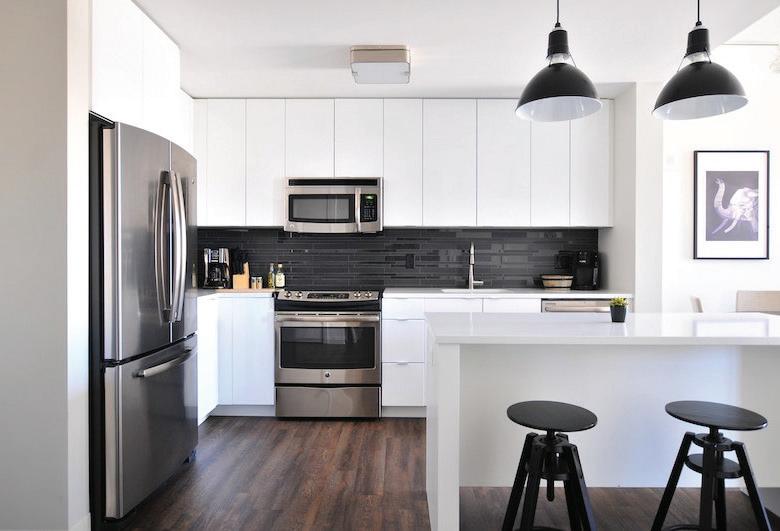
Actually, the challenge persists all across the Midwest. And while it’s great for the regional economy, it’s not so great for renter morale.
Though Miami was the most competitive rental market during this summer’s peak moving season, the Midwest has been declared America’s hottest apartment region, due to the wide range of housing options and a lower cost of living compared to the coasts.
In its newest report, RentCafe analyzed 139 markets in the U.S. where data was available, by using five relevant metrics to rank the nation’s hottest renting spots in peak season: (1) the number of days apartments stayed vacant; (2) the percentage of apartments that were occupied by renters; (3) how many renters applied for the same available apartment; (4) the percentage of renters who renewed their leases; and (5) the share of new apartments opened recently.
To determine the rental market’s competitiveness, they calculated a Rental Competitivity Index (RCI). In peak rental season, the national score was 60, which means that the apartment market was moderately competitive during the year’s busiest time for renting.
Let’s
get into it.
First up on the list, Milwaukee emerged as the second most competitive rental market in the country in peak rental season, with a RCI score of 116. Available rental apartments here fill within a month, with 16 renters competing for each vacant unit.
Following as the fourth-hottest rental market in the country, Suburban Chicago boasted a RCI score of 112. Cities like Joliet, Aurora, Naperville, Elgin or Skokie in Illinois—stretching as far as Gary and Hammond in Indiana—offer more space and a less-congested place to call home, driving competition, based on the report.
In fact, Suburban Chicago climbed six spots since the start of the rental
season. And with less that 5% of the rentals here available and little to no apartments built recently, 67.3% of apartment dwellers in the area decided to just stay put.
Not to mention, RentCafe reported that those who are looking for a new home must compete with 14 other renters to secure an apartment. On average, a vacant unit in Suburban Chicago is occupied within 33 days.
Other Midwestern markets that are highly competitive include Grand Rapids, Michigan; Omaha, Nebraska; Kansas City, Kansas; Cincinnati; and Chicago.
Midwest Real Estate News | September 2023 | www.rejournals.com 30
RENTAL



2023 St. Louis COMMERCIAL REAL ESTATE summit October 26, 2023 Scan for more information and to register www.rejournals.com/upcomingevent/ Speaking and Sponsorship opportunities available Ernie Abood eabood@rejournals.com 773-919-8799 Hilton St. Louis Frontenac 8:00am Breakfast, Registration, and Networking 9:00am - 12:00pm Program 6th Annual
Employees returning to the office? It’s not happening yet … especially not in the United States
By Dan Rafter, Editor
Zoom made headlines in August when the video-conferencing company told employees who live near an office to work from that space at least two days a week.
And Zoom isn’t the only big company that is mandating or strongly recommending that its employees return to the office. But are these orders actually bringing workers back to their cubi-
cles, conference rooms and collaboration spaces? Not really, according to a newly released study.

According to the second-quarter 2023 Workplace Utilization Index from XY Sense, office space around the globe was used just 30% of the time during the second quarter of this year.
This shouldn’t be too surprising to anyone watching the office sector
throughout the Midwest. Vacancies remain high here, and the majority of office employees are still working from home at least part of the time.
And Alex Birch, founder of XY Sense, told Midwest Real Estate News that this 30% figure might be the sign of a longer-lasting new normal in the office sector.
“This year we didn’t have any major COVID impediments where we saw new lockdowns,” Birch said. “Given that this is the first year of no new COVID developments and no new influence from COVID, are we starting to see what is a new normal in the office sector? Is this the effect of large enterprise companies dealing with long-term office leases?”
Midwest Real Estate News | September 2023 | www.rejournals.com 32
OFFICE
Photo by Pawel Chu via unsplash
As Birch said, many of the biggest companies are locked into longterm office leases. They can’t move as easily to new, smaller space. Because of that, there’s plenty of office space around the globe that is simply not being used most of the time.
And that indicates what might be a long recovery for the office sector.
Consider the numbers from XY Sense’s second-quarter report, which aggregates data from 24,885 workspaces across the United States; the Europe, Middle East and Africa geographical grouping; and the Asia-Pacific region. This data comes from XY Sense’s network of sensors installed in client workspaces, sensors that passively monitor office areas to collect
real-time insights. XY Sense says that office-utilization numbers are updated every two seconds.


According to the Workplace Utilization Index, levels of workplace utilization have plateaued at about half pre-pandemic levels. Days of the week matter, too. The index found that office utilization numbers are 84% higher on Tuesdays,
Wednesdays and Thursdays than they are on Mondays and Fridays.
The report found that office usage was highest on Tuesdays at 38.2%, and lowest on Fridays at 18.2%.
What’s interesting is that U.S. office-usage rates were the lowest of all
For over 45 years, DarwinPW Realty/ CORFAC International has been a leader in industrial and commercial real estate. The company specializes in brokerage, property management, investment and development services primarily in the Midwest. DarwinPW Realty’s highly qualified professionals are problem solvers and utilize a breadth of tools and knowledge to serve our clients best.

www.rejournals.com | September 2023 | Midwest Real Estate News 33
OFFICE
Alex Birch
“At DarwinPW Realty, we look at building long term relationships and we achieve this by putting our clients’ interests above all others.
630.782.9520 | darwinpw.com OFFICE (continued on page 34)
Jerry Sullivan Principal
Broker
“Are we starting to see what is a new normal in the office sector? Is this the effect of large enterprise companies dealing with long-term office leases?”
the countries tracked in XY Sense’s report. The report found that U.S. office space was used just 20% of the time during the second quarter of this year. That’s lower than the 35% usage rate recorded in the Asia-Pacific region and far lower than the 52% usage rate seen in the United Kingdom. The United Kingdom’s office-utilization rate was the highest in XY Sense’s second-quarter report.
Birch pointed to several possible reasons for the lower office-utilization rate in the United States.
Home sizes are larger here, which makes it possible for more workers to work comfortably from home offices. As Birch says, it’s the opposite of what many workers in Japan face. He points to a remote call XY Sense had with a client in Japan. That client had to take
the call in a closet as it was the best available private space in the client’s home.
Commute times matter, too, Birch said. Many workers moved even further from their offices during the pandemic. That’s another incentive for these workers to remain in their home offices.
Technology has improved, too. Birch said that tech is good enough today so that many office workers can do their jobs completely from home.
And one other factor? The independence of U.S. workers.
“People in the United States don’t like to be told what to do,” Birch said.
That last factor might be an important one. As Birch says, it’s one thing for companies to mandate that workers return to the office, at least on a
part-time basis. But it’s another for these companies to enforce these mandates.
“There’s a gap and a disconnect between what companies are saying and what they are actually doing,” Birch said. “They’re not always enforcing these mandates. And if they aren’t, then many employees simply aren’t listening to them.”
That doesn’t bode well for a return to pre-pandemic levels of office usage anytime soon.
“While individual companies may see increases in office attendance and utilization, it’s clear that most businesses won’t see a return to pre-pandemic office utilization levels in the foreseeable future,” said XY Sense head of customer success Shivaun Ryan, author of the report. “We’ve reached a new normal. The question is how workplace leaders are going to
adapt their office portfolios to meet this new status quo.”

XY Sense’s report also revealed changes in workers’ activities while they are in the office. In the first quarter of this year, XY Sense reported a 24% utilization rate for collaboration spaces compared to a lower 18% workplace utilization rate for individual workpoints such as workers’ desks or cubicles.
That changed in the second quarter when the utilization spaces for individual spaces increased by 67%. According to XY Sense, this indicates that workers are performing a more balanced blend of individual and group work than they were at the beginning of the return-to-office movement. Back then, workers spent most of their in-office time participating in group discussions and meetings.
OFFICE (continued from page 33)
Photo by Chris Montgomery via unsplash
How are companies trying to get their employees to return to the office?
Birch says that companies are trying everything from official mandates to perks that make coming into the office more enjoyable.
He points to the amount of free food that some companies are offering to their workers. Then there is the move to higher-quality office space. Those companies that can afford to move, and have approached the end of their leases, often move to higher-quality space as a way to entice workers to come into the office at least two or three days a week, Birch said.
This trend is having an impact on the commercial office sector. When companies move to higher-quality space, they are often leasing less of it. That makes financial sense: By leasing less space, companies can afford the higher costs of the higher-quality spaces they are leasing. But that does leave a lot of unused office space across the globe.

The trend is especially troubling to Class-B and Class-C office space that
lacks the modern amenities and collaborative spaces that today’s tenants seek.
“Companies are experimenting with a variety of approaches to bring workers back,” Birch said. “They want their employees to come in and connect with each other, even if it is for a shorter amount of time. The general sentiment is that companies want people to come back more often so that they can
collaborate and be able to understand each other’s missions and values. All different forms of experimentation have happened to try to make this a reality.”
Despite the sluggish return to the office, Birch does predict that the 30% utilization figure will increase over time, even if that increase takes longer than anyone predicted during the height of the COVID pandemic.
“That 30% number has to change,”. Birch said. “It just will change more slowly than organizations would like. With the duration of office leases and the time it takes for companies to downsize and find new space, it will take time. We will see the utilization percentage increase. But it will be a gradual increase
www.rejournals.com | September 2023 | Midwest Real Estate News 35
OFFICE
“Companies are experimenting with a variety of approaches to bring workers back. They want their employees to come in and connect with each other, even if it is for a shorter amount of time.”
The battle to bring workers back to the office: What’s the right approach?
 By Jesse Meschuk, Senior Advisor, Exequity
By Jesse Meschuk, Senior Advisor, Exequity
Each week, the number of organizations announcing their return to the office grows. Zoom, the company whose technology helped drive the remote work movement during the pandemic, recently announced its employees would also need to return to the office. It seems corporate America went from strongly embracing remote work to strongly discouraging (or disallowing) time away from the office. Why the dramatic shift, and what’s the right strategy to follow?
This is the question rattling around C suites across the country, and the answer deserves a more nuanced approach than it has received. If the COVID-19 pandemic opened leaders’ eyes to the possibilities for remote- and hybrid-work arrangements, the intervening years offered the opportunity to reflect on corporate America’s successes and failures.
What’s worked well
• Employees are productive working remotely and report they are better able to balance life’s demands: According to a 2022 Gallup poll, hybrid workers have been able to maintain their work performance while also meeting other life responsibilities, such as running errands or taking children to school and activities. A Pew survey published in March found that 41% of those whose jobs can be done remotely are working a hybrid schedule.
• Companies have gained access to broader and expanded talent pools: Remote work allows recruiters to draw from a larger talent pool. Many have discovered previously underutilized talent pools in lower-cost locations across the United States or globally. Additionally, employers find it easier to plug in remote workers on a part-time basis who previously couldn’t work full-time in person because of family commitments or because they were semi-retired and wanted to work fewer hours. This reduced the time needed to fill roles and helped keep overall employment costs from escalating further (as more supply helps to better balance demand).
• Many employees report greater job
satisfaction, as they have more freedom over their schedule: Beyond its impact on the productivity of existing staff, freedom can be a useful recruiting tool. For employers who can’t afford to match salaries offered by a deeper-pocketed competitor, workplace flexibility—such as the option to work remotely—can provide a useful edge.
What hasn’t worked well
Employers do have some good reasons for wanting employees back in the office for at least part of the time:
• Employee commitment and engagement have suffered in an all-remote scenario, as it’s hard to maintain a connection to the organization when there are no informal interactions. It’s also more difficult to create real moments of connection during company meetings or departmental meetings when they are conducted over video conference. It’s harder to make friends at work, connect with your team and feel part of a community, too.
• Communication between departments has dropped, with many noting
that employees and teams have become increasingly siloed through the work-from-home/remote work evolution.
• Collaboration and practicality: A remote or hybrid approach is not always practical. If you are a creative company that makes podcasts, TV shows, disruptive technology, etc.—any process that requires heavy brainstorming— the advantages to collaborating with colleagues in person are obvious. A Pew survey noted that 61% of U.S. workers simply do not have jobs that
Midwest Real Estate News | September 2023 | www.rejournals.com 36
OFFICE
Photo by Jose Losada via unsplash
can be done from home, and even among those who can work remotely, the need to collaborate require some face-to-face time to work effectively and with quality.
Practical considerations for the path forward
The reality of most corporate environments today is that work is complex: Duties can change from week to week and day to day, from team to team and person to person. Assigning remote and in-person work roles will—and sometimes should—be dynamic and flexible, rather than fixed in place. Navigating those complexities remains a central challenge for today’s leaders.
The following considerations can help assist the process of deciding which work model is best.
1. Consider your personnel and what they’re doing right now. Empower your leaders to make the right calls for their teams vs. dictating a onesize-fits all solution.
Say your organization consists of 10 teams. Three don’t need to be in the office except for key meetings or brainstorming sessions. Three don’t need to be in at all. The other four require intense collaboration on a key deliverable, by a certain deadline, and need to be working in sync. In this scenario, it’s essential for a middle manager or team leader to be aware of the roles within each team, how the teams interact with one another and the relevant deadlines that will dictate who’s in the office when, and to empower these leaders to make the best decisions for their teams. Support those teams by helping make it easier for them: Consider holding defined
“collaboration days” for members of your remote teams to gather in-person while scheduling lunches, speakers and social events around them to create the right pull into the office.
2. Think about where your products are in their life cycle and the current state of how your teams work together.
Consider being more flexible in allowing employees to work from home as your products allow. When preparing for a new product launch, or when multiple teams are involved in the early stage of product design or ideation, keeping your teams in the office makes sense relative to later in the product cycle. These factors are ever-changing and might require revisiting your work arrangement over time.
Here, the demographics of your organization might come into play. A senior organization whose members have worked together for a decade probably has the discipline, teamwork and resilience to overcome the challenges posed by working at a distance from one another. A more junior team that needs mentoring might have more of a need to gather in person.
3. Consider what your competition is doing, and your relative employee value proposition.
If your organization insists every employee reports to an office but your direct competitors allow for a hybrid model, you’re at a disadvantage. Enforcing a policy that effectively promotes attrition will harm the business, so be clear on what your talent peers are up to and why. Take a look at what is driving your decision-making. Does
a more flexible work environment help you compete?
4. Consider all the nuanced costs and benefits of a remote work or in-office solution.
• Avoid sunk cost mentalities: An organization’s internal budget can and should guide your thinking. But when it comes to your office space or lease, budget shouldn’t be the driving factor behind your workplace strategy. Instead, you should focus on what makes sense for your business. If you discover your strategy should allow for more remote or hybrid work and you need less space, investigate opportunities to downsize or sublet the office space instead of requiring in-person attendance.
• If you have a large number of employees near a main office, a hybrid solution might be practical and address some of the concerns of remote work. For those with a highly distributed workforce across geography, requiring frequent flights for meetings and other in-person activities, an in-office requirement might be costly and impractical. If your strategy has evolved and it doesn’t make sense to have as many remote employees, consider what incentives to put in place and what hiring guidelines make sense moving forward to avoid deepening the problem.
• Carefully consider international hires moving forward: Globally distributed workforces can present practical concerns, from the administrative burden to compliance with various local labor laws, legal entity requirements and more. Payroll services companies can help, but still require a heavy lift that may not always pen-
cil out if you have one to two people in each country. In this case, select “hubs” or “approved regions” for hiring within, limiting your list to regions aligned with your demographics and desired talent strategy to balance the cost/benefit equation.
• Use data to guide and iterate: As you adjust and re-adjust your remote-work policies, use actionable data to inform the strategy. Requiring employees to work in your office isn’t the only way to measure and promote productivity. Software tools like Slack and Teams allow leaders to monitor when employees are active, inactive or in meetings. (Ask IT to cull daily or weekly data if you don’t want to monitor your workers’ activity from minute to minute.) This can help you measure whether your policies are promoting productivity.
Ultimately a flexible or remote work policy might not be best for your organization. But for the roughly 40% of workers whose jobs can be done remotely, consider a nuanced approach. You may find that through the appropriate flexibility, testing and experimentation, you arrive at the right equilibrium that delivers the best results, while maintaining the flexibility required to move your organization forward.
Jesse Meschuk is a career and human resources expert and a senior advisor with Exequity. He has more than 20 years of consulting and human resources experience and has worked across a variety of industries including technology, entertainment, gaming, retail, hospitality and sports. Meschuk’s work has spanned across the Americas, Europe and Asia.

www.rejournals.com | September 2023 | Midwest Real Estate News 37
OFFICE
Jesse Meschuk
“An organization’s internal budget can and should guide your thinking. But when it comes to your office space or lease, budget shouldn’t be the driving factor behind your workplace strategy.”
PACE: The chameleon of CRE financing
By Rafi Golberstein
One bright spot in an otherwise dreary capital markets environment has been the continued emergence and success of PACE (Property Assessed Clean Energy) financing, a surprisingly adaptable funding source that has proved to be effective in varied market conditions.
PACE is a privately funded, long-term (20 to 30 years), low-cost, fixed-rate source of financing that can reduce equity, or senior debt, and boost returns. It is approved state-by-state and is available for properties and developments that have elements of energy efficiency, renewable energy, water conservation, flood mitigation and seismic retrofits. One of the unique features of PACE is that it is secured by a special assessment lien instead of a mortgage, meaning the assessment can stay with the property through various owners over its term.
PACE as an “equity reducer and IRR juicer”
In strong markets, when construction financing is readily available, competition results in mortgage lenders increasing leverage or accepting more structured capital stacks. In this case, PACE substitutes more expensive mezzanine financing and/or preferred equity.
For example, 18 months ago a developer might have been able to obtain 70% leverage from a bank at a 4% interest
rate. To achieve a higher leverage, such as 85%, that developer would typically look to mezz and/or preferred equity, which would command 10%plus returns. PACE filled the same slug in the capital stack at a lower rate, significantly reducing the cost of capital and increasing developer yields. Thus, PACE acts as an “Equity Reducer and IRR Juicer.”
Such was the case at The Grove, a new 222-unit senior living facility located within a mixed-use community in Austin, Texas. PLG funded this project in 2022 and the developer used PACE to increase its leverage by approximately 10%, effectively reducing cash equity and increasing proforma IRRs. The PACE had the added benefit of being associated with water and energy-efficiency improvements that are expected to generate $484,656 in annual savings.
When financing is scarce
But with interest rates now at levels never seen by the youngest generation of owners and developers, credit has tightened, and mortgage borrowing has become both expensive and difficult. If a mortgage is being priced at Prime + 1.50% or SOFR + 4.50%, the interest rate (as of August 2023) would be nearly 10%.
In these scenarios, PACE shifts its utility and becomes a “cost of capital reducer,” blending down the interest rate and reducing more expensive financing. For example, if PACE prices in
the mid 7% range, every dollar of PACE that is used to reduce the mortgage is accretive and saves the developer money.
An example of this is a deal that PLG recently closed in Orlando, Florida. The developer was converting a vacant 151-room hotel to workforce housing. The mortgage lender, a regional bank, quoted the deal with a “not to exceed” loan-to-value requirement and priced its debt over prime. The developer realized that was an inefficient capital stack and introduced PACE. Ultimately, the developer opted to purse a combined $13.8 million PACE loan and $9 million mortgage. The total debt of $23.8 million stayed within the bank’s loan-to-value limitation but significantly reduced the developer’s cost of capital by using more PACE than mortgage debt.
PACE for liquidity
Another application of PACE is retroactive financing. Most states allow a one- to three-year lookback for PACE loans, meaning over the past 12 to 36 months a property has benefited from PACE eligible improvements (i.e., nearly any project built over the past few years). In those scenarios, owners can utilize their PACE eligibility and be reimbursed for the previously expended eligible PACE dollars, creating a liquidity event in an otherwise illiquid market.
In the case of the Four Seasons at RBC Gateway, a newly constructed hotel in Minneapolis, PACE Loan Group provid-
ed a $20M retroactive PACE loan to the developer, allowing them to capture liquidity and re-deploy those funds into other projects. In today’s environment, retroactive PACE is a smart way to create a liquidity event and use those proceeds to negotiate loan extensions and modifications for existing construction loans that are coming due.
Property owners of all property types can utilize PACE – but we know that it may be hard to understand. My tip is to ask questions, understand what your state allows and work with people who will dig into the details and stay only a phone call or email away. Watch out for broker reselling C-PACE. Instead, work with a firm that can has guaranteed capital and quick decision making -because C-PACE is a chameleon with the flexibility to fit almost any financing challenge.
Rafi Golberstein is chief executive officer of PACE Loan Group, a national leading direct lender providing C-PACE financing to commercial property owners with capital from funds managed by AB CarVal. Based in Minneapolis, the PLG team provides expertise up and down the capital stack, from origination and underwriting to loan servicing for PACE loans that can be used for renovations, ground-up construction, and seismic retrofits for any property type. PLG originates loans where PACE is available -- in 40 states.

Midwest Real Estate News | September 2023 | www.rejournals.com 38
Rafi Golberstein
“In strong markets, when construction financing is readily available, competition results in mortgage lenders increasing leverage or accepting more structured capital stacks.”
NEWS BRIEFS: The latest deals in the Midwest
Meridian Design Build wraps construction of 479,000-squae-foot distribution center in Cedar Rapids
Meridian Design Build completed construction of a 479,000-square-foot package sorting and distribution center for developer Scannell Properties on a 79-acre site in Cedar Rapids, Iowa.
The new facility, built for a provider of global shipping and information services, is located at 1035 Commerce Park Drive SW in Cedar Rapids.
The new building includes 190 loading docks, 12 drive-in doors, 168 interior van loading positions and 31,977 square feet of office space. The site accommodates a 660-car parking lot, 189 van storage spaces, 130 tractor parking spots and a 330-stall trailer storage yard.
Meridian completed the project on a design-build basis with Cornerstone Architects providing architectural design services and Manhard Consulting handling civil-engineering design.
St. Louis’ Contegra Construction building 220,000-square-foot production facility in Missouri
Contegra Construction Co., one of St Louis’ largest general contractors, is building a 220,00-square-foot production facility in Washington, Missouri, for AZZ Precoat Metals, an independent metal coil coater.

Contegra is scheduled to complete the building in spring 2024. Production equipment will be installed in the second half of 2024 with production anticipated to commence in 2025.
Precoat Metals’ production expansion will meet increasing demand for coated aluminum coils slit to custom widths and will augment the firm’s current production capabilities for customized steel, aluminum and galvanized metal coils used in containers,buildings, housing, automobiles, product storage, appliances, HVAC and more.
Located at 901 Waterman Drive, Precoat is the first tenant to emerge in the new 115-acre Oldenburg Industrial Park in Washington. The plant will employ approximately 88 once production commences in 2025.
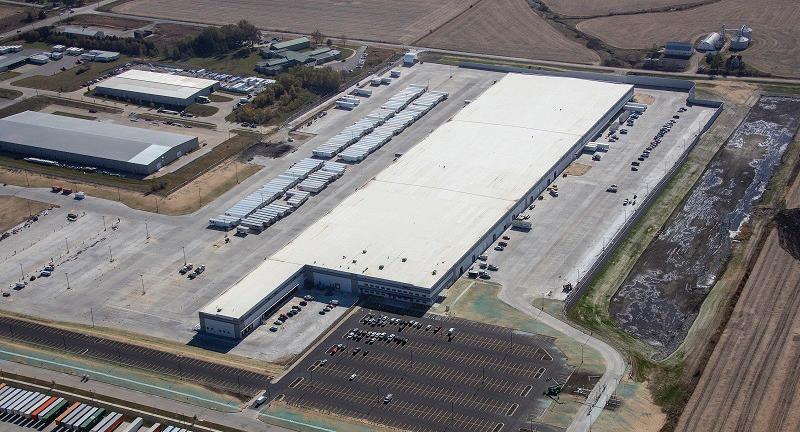
The pre-engineered building will host a 212,000-square-foot production zone and 8,000 square feet of office space. The production zone will be served by three 30-ton overhead cranes and advanced equipment for preparing,
coating, slitting, and packaging aluminum coils.
The facility will feature eight loading dock bays and six drive through bays.
Joining Contegra on the project are Vision Electric, electrical; Jarrell Mechanical Contractors, HVAC; O.J. Laughlin Plumbing Company, Inc., plumbing; and Musselman & Hall Contractors, concrete.
Contegra previously built a 53,000-square-foot expansion at PreCoat’s MMC Granite City production facilities growing the operation to 143,000 square feet of processing and storage space.
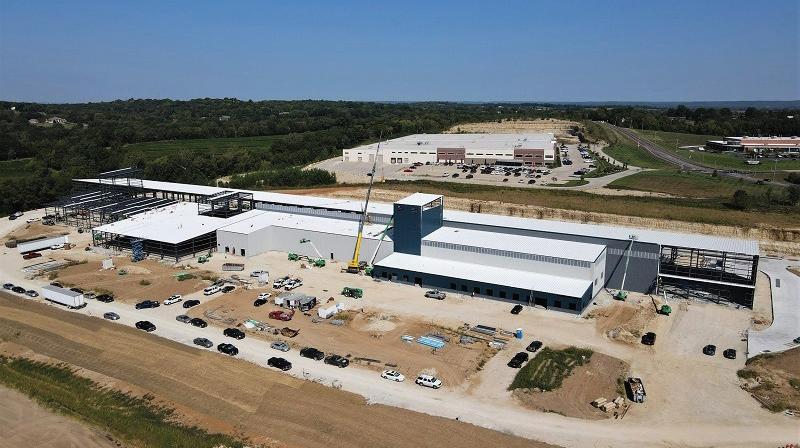
Marcus & Millichap sells 83-room hotel in Wisconsin

Marcus & Millichap closed the sale of the Best Western Plus Wausau-Rothschild Hotel, an 83-room hospitality property in Rothschild, Wisconsin.
Chris Gomes, Executive Managing Director; Allan Miller, Senior Managing Director; Ebrahim Valliani, First Vice President; and Michael Gantman, Associate; all investment specialists in Marcus & Millichap’s Chicago Oak Brook office, had the exclusive listing to market the property on behalf of the seller, a private investor.
The buyer, a private investor, was secured and represented by Miller, Gomes, Valliani and Gantman. Todd Lindblom, Regional Manager and Broker of Record of Wisconsin, assisted in closing this transaction.
Best Western Plus Wausau-Rothschild Hotel is located at 803 Industrial Park Ave. in Rothschild.
The Miller-Gomes Hotel Team of Marcus & Millichap has sold over 570 hotels across the nation since its inception and closed 52 hotels year-to-date as of August 2023. The team has over 50 active listings and more than 20 assets under contract.
Three Light Luxury Apartments opens in Kansas City’s Power & Light District
The Cordish Companies and Power & Light District recently announced the grand opening of Three Light Luxury Apartments in Kansas City, Missouri.
Team members from The Cordish Companies and Power & Light District were joined by Mayor Quinton Lucas, City Manager Brian Platt, city officials
www.rejournals.com | September 2023 | Midwest Real Estate News 39
BRIEFS
Coontegra Precoat
Best Western
Cedar Rapids Build to Suit
BRIEFS
and distinguished guests from the City of Kansas City to celebrate the opening of the brand-new addition to Kansas City’s skyline.
A landmark tower of gleaming glass, Three Light joins its sister properties, One Light and Two Light – both 97% occupied, as the next phase of luxury living in the Power & Light District.With its own distinctive take on an immersive downtown Kansas City lifestyle that offers convenience and walkability, Three Light sits steps away from the legendary Midland Theatre, Cosentino’s Downtown Market, Kansas City Live!, T-Mobile Center, Genesis Health Clubs, KC Streetcar line, dozens of restaurants, shops and entertainment venues, cultural destinations like the Kauffman Center for the Performing Arts, and forthcoming South Loop Link Park over I-670.
Since the opening of the nine-city block Power & Light District, which is celebrating its 15th anniversary this year, downtown Kansas City has garnered national attention for its urban renaissance. The transformation has included more than $9.7 billion in public and private investment over the last 15 years, with more than 12,111 new apartment units and 5,326 new or renovated hotel rooms, as well as the KC Streetcar line. The Power & Light District, developed by The Cordish Companies, is the most visited destination in the state of Missouri welcoming over 10 million visitors per year.
For nearly two decades, The Cordish Companies has invested in downtown Kansas City, both new construction projects and the restoration of historic buildings including the B&B Theatre and a two-year, multi-million dollar renovation of the Midland Theatre, which first opened its doors in 1927. Earlier this summer, Cordish commenced construction on Midland Lofts, the transformation of the historic Midland Office Building – an underutilized jewel that has been vacant for more than 20 years – to 135 loft apartments. Upon completion in May 2024, Cordish will have added over 1,000 new residences to downtown KC since One Light’s opening in 2015.
Located at the corner of Truman Road and Main Street, the new 25-story, 288unit building includes a seven-story parking garage with 472 spaces, as well as 7,600 square feet of ground-level retail space. With units starting at $1,350/month, there is a wide variety

of unit sizes and floorplans including spacious studio apartments, one- and two-bedroom units, and designer penthouse apartment homes. Units boast floor-to-ceiling windows with inspiring city views, gourmet kitchens, premium stainless-steel appliances, luxury quartz countertops, full-size washers and dryers, and private balconies in select residences.
Three Light offers residents over 30,000 square feet of resort-style amenity space and expertly curated concierge services on par with any apartment or condo building in the country. Amenities include:
multiple televisions to entertain or relax
• Pet-inclusive community including dog washing stations, dog walking, grooming and away-from-home services
• Business center and conference room
• A variety of coworking spaces
• Fitness center
• Infrared sauna
• Valet dry cleaning and laundry services
• Controlled-access building, including parking garage
• 24-hour lobby attendant and personal concierge services, including VIP access to events and venues in the Power & Light District and around Kansas City
Cushman & Wakefield closes 33,690-square-foot lease in St. Paul


Cushman & Wakefield has represented landlord Securian Financial in leasing 33,690 square feet at 400 Roberts Street North in S. Paul, Minnesota, to Redpath and Company for its new headquarters location.
Cushman & Wakefield’s Tom Stella and Eric King represented Securian Financial, while Mike Salmen of Transwestern represented Redpath and Company.
With the headquarters relocation, the locally based CPA firm retains its base in Downtown St. Paul.
• An expansive eighth-floor outdoor terrace featuring an infinity-edge pool overlooking 14th street
• Clubroom featuring a full-service resident bar and fireplace
• Indoor-outdoor party room
• Demonstration and entertainment kitchen
• State-of-the-art jazz-inspired theater room experience
• Game room featuring plush seating, cozy fireplaces, a billiards table, and
400 Roberts St. N., also known as Securian Center, is a Fitwell 1 Star rated building with amenities such as Skyway connectivity in four directions; a work café with outdoor patio seating; onsite childcare; conference and training center: on-site, 24/7 security; and access to area restaurants and retail.
“Now more than ever, it’s important to retain locally based businesses like Redpath and Company in Downtown St. Paul,” said Stella, a Senior Director at Cushman & Wakefield. “And while it’s a sign of positive momentum for the area, it’s also a testament to the quality of Securian Center and its unmatched location and amenities.”
Colliers Mortgage closes $10.8 million acquisition loan for Columbus
Midwest Real Estate News | September 2023 | www.rejournals.com 40
Three Light Luxury
VIEW on Grant
Securian
apartment property
Zach Shope of the Colliers Mortgage Atlanta office closed a $10.8 million Fannie Mae loan for a repeat client for the acquisition financing of The View on Grant in Columbus, Ohio.
The 86-unit market-rate multifamily property is in the Discovery District and is walking distance to some of the city’s largest employers, as well as several educational institutions, culturaland arts-based attractions, and dining and entertainment options.
The property is an adaptive reuse of a former 5-story steel pressing factory featuring a modern industrial architecture style. Included in the property are a public café and a 43-space automatic stacked parking garage.
The 10-year term loan was arranged for borrower, VOG Owner LLC.
Cushman & Wakefield to market Emmis Corporation’s Indianapolis headquarters
Emmis Corporation announced that commercial real estate firm Cushman & Wakefield has been selected to market its corporate headquarters at 40 Monument Circle.

A sale would not immediately impact the building’s current tenants, Star Bank and Urban One.
The seven-story, 140,000-square-foot building is located directly on Monument Circle, the epicenter of Downtown Indianapolis. The property offers a contiguous block of 100,000 square feet of Class A office space ideal for prestigious office headquarter space for owner-users or corporate tenants. With its expansive, three-story atrium, 40 Monument Circle has the potential for tourism-retail and high-end dining as well. The property’s offering also includes a right of first refusal to acquire the adjacent parking garage as well as air rights over the garage for a potential building expansion.
Cushman & Wakefield’s Rebecca Wells will lead efforts with support from John Crisp and Spud Dick to identify a buyer for the Downtown Indianapolis landmark.
Given its prime location, 40 Monument Circle has a 97 Walk Score and access to more than 440 restaurants and bars, 32 cultural institutions, 14 monuments
BRIEFS
ing greater equity for marginalized communities.”
Berkadia closes sale of 120-unit multifamily property in St. Louis
Berkadia brokered the sale of Majestic Stove Lofts, a 120-unit, loft-style multifamily property in St. Louis, Missouri.
Managing Directors Andrea Kendrick and Ken Aston and Senior Director Bobby Mills of Berkadia St. Louis led the transaction on behalf of the seller, St. Louis-based Regency Realty Co, LLC.
Majestic Stove Lofts sold to California-based buyer on July 17. The property was 96 percent occupied at the time of the sale.

Located at 2017 Washington Avenue, the property affords convenient access to Highway 44 and Highway 64. Majestic Stove Lofts was built in 2006 and features 120-units with loft style features.
Saint Paul’s The Heights redevelopment earns LEED Platinum precertification

The Saint Paul Port Authority has successfully earned a LEED for Communities Platinum level precertification for The Heights, a brownfield redevelopment project slated to bring 1,000 new housing units and 1,000 living wage jobs to Saint Paul, Minnesota’s, Greater East Side.
and memorials and more than 340 acres of park and green space.
KeyBank provides $10 million loan to Cinnaire Lending Corporation
Cinnaire Lending Corporation, a certified Community Development Financial Institution (CDFI), has been awarded a $10 million loan from KeyBank’s CDFI Lending & Investment Group.
The Loan will support Cinnaire’s lending pool, which works with mission-driven investors to create out-of-the-box lending products to finance affordable housing, education, healthcare, community facilities and economic development projects. Cinnaire will leverage KeyBank’s capital to invest in underestimated communities that
have been systematically denied access to capital, primarily in KeyBank’s footprint states including Pennsylvania, Indiana, Ohio, and Michigan.
As a certified CDFI, Cinnaire Lending is a trusted partner with nonprofit organizations, government agencies, and mission-driven for-profit businesses to connect communities, regardless of income or zip code, with financing that supports economic growth and opportunity.
“Racial and economic equity are core to Cinnaire’s mission,” said Brian Maddox, National Team Leader for KeyBank Community Development Financial Institutions group. “KeyBank and Cinnaire share a common commitment to increasing access to capital and bring-
This award was granted by the U.S. Green Building Council as part of its LEED for Cities and Communities certification program. Platinum is the highest level to be obtained and puts The Heights on course as the first project in the State of Minnesota and one of fewer than 55 communities worldwide to reach this milestone.
“This precertification represents the Port Authority’s dedication to equitable and sustainable development. From day one, our objective at The Heights has been to bridge social, economic, and environmental investments to protect the health and wellness of those who live and work on the Greater East Side,” said Kathryn Sarnecki, chief development officer for the Saint Paul Port Authority. “Our next step is to find businesses that are poised for growth and share our commitment to sustainability to relocate to our light industrial parcels.”
www.rejournals.com | September 2023 | Midwest Real Estate News 41
40 Monument Circle
Majestic Stove lofts
The Heights
A LEED for Communities Platinum® certification is achieved through a comprehensive rating system evaluation. To achieve Platinum certification, a minimum score of 80 points is required. The Heights received 87 points.
“After working closely with the Port Authority on this project, LHB is excited to see that the precertification score validates the work we’ve done on the front side and verifies that we’re on the right track with our plans for The Heights,” adds Rick Carter, chief executive officer for LHB.
Reflecting on these results, Asa Posner, vice president of sales, Sustainable Investment Group states, “Our engineers and LEED consultants have thoroughly enjoyed guiding the Port on precertification and are grateful to be part of the shared vision for a more equitable, resilient, prosperous, joyful, and sustainable community on Saint Paul’s Greater East Side.”
CBRE closes sale of 435,000-squarefoot office complex in Milwaukee

CBRE has arranged the sale of 100 East, a 435,000-square-foot office complex in Milwaukee.
100 East PropCo, LLC, purchased the property from Michael S. Polsky, Esq., the court-appointed receiver for Hertz Milwaukee 100 East Wisconsin, LLC, for $28.75 million.
CBRE’s Patrick Gallagher, Matson Holbrook, Bill Bonifas and Matt Cariello represented the seller in the transaction.
The 35-story building is located at 100 E. Wisconsin Ave. in the Downtown East submarket, three blocks from the Third Ward and proximate to I-794 and I-43 interchanges. The property was built in 1989 and has direct access to the RiverWalk along the Milwaukee River, the 1.75-mile skywalk system and 750 parking spaces contained in both the building and a nearby 10-story parking garage at 720 North Water St.
The tower was 46.5% occupied at the time it was marketed for sale.
Sherman Associates celebrates grand opening of 10-story mixed-use development in Minneapolis
Sherman Associates along with development partners, residents, and prospects celebrated the grand open-
ing of Moment, a 10-story mixed-use development with skyway connection that includes 222 market-rate apartments and nearly 15,000 square feet of street-level commercial space including Starbucks and a future New Horizons Academy daycare center at 650 Portland Ave. in Minneapolis.
Firefighters For Healing and its Transitional Healing Center are located on the 2nd floor, the center being the first of its kind in the United States, with 12 fully furnished Home Away from Home suites available to families of burn survivors, firefighters, and first responders traveling to the Twin Cities for care at nearby Hennepin Healthcare.
“Moment shows what is possible through the partnering of businesses, cities, and non-profits to create a better neighborhood, support those in need, and deliver high-quality housing and community amenities,” said George Sherman, CEO of Sherman Associates.
Sherman’s $83 million development signifies its dedication to creating a vibrant downtown for residents, businesses, and workers. Moment was fueled by the shared commitment to the reanimation of Minneapolis by all parties involved in the development.
distance to additional bus stops, grocery stores, restaurants, shopping, and entertainment.
Being connected to the skyway system is an added amenity for residents, guests, customers, and employees. An onsite bike storage and repair area further encourages green modes of transportation. Compact stalls and future electric vehicle charging stations in the underground parking garage promote the use of more energy-efficient vehicles. Energy usage for Moment is partially offset by energy production from a solar garden located in Carver County.
Residences at Moment range from efficient 496 SF studios to spacious Penthouses with more than 1700 SF, complete with STRATIS Smart Home Technology. Each home features stainless steel appliances, quartz countertops, and in-home washer/dryer. Most homes have a private balcony, built-in desk with open shelving, smart refrigerator with remote monitoring and temperature control, and smart gas range with voice-enabled controls.
The project was financed by a bank group led by TCF Bank, now Huntington Bank. ESG Architecture & Design was the architect and Kraus-Anderson was the general contractor.
“This project is the result of many factors coming together when the world was quickly evolving due to the COVID-19 pandemic,” said Carole Mette, Senior Developer at Sherman Associates. “Our team, along with our steadfast partners, overcame the challenges together and brought the project to the finish line.”
Sherman acquired the site from Thrivent Financial in May 2021, which occupies the lot adjacent to Thrivent’s headquarters. Moment and Thrivent are linked by a shared driving court, underground parking garage, and skyway connection. Moment contributes to Thrivent’s vision of a thriving neighborhood in downtown Minneapolis.
Moment is a transit-oriented development representing Sherman’s dedication to environmental sustainability. It promotes the use of sustainable transportation practices for its residents, guests, customers, and employees being located on a high-frequency bus route and only a five-minute walk to the light-rail system, as well as walking
Residents benefit from a variety of luxury amenities including a modern 5-star lobby, pool terrace, sauna and spa, sports simulator, rooftop terrace, fitness studio, work-from-home space, maker’s space, bike storage and repair area, dog run, and pet spa.
Moment curates a living environment designed to inspire a “live in the Moment” approach to daily routines. Design and artwork selections support a resurgence to the feel-good supply of Moment’s residents. This theme seeks to provide needed moments of joy to the burn survivors and their families staying at the Firefighters For Healing Transitional Healing Center as they navigate the difficult journey to recovery. A Moment-themed mural by Juxtaposition Arts in the skyway greets guests and visitors as they pass by on the way to the Transitional Healing Center.
Moment joins Sherman’s vast development portfolio of over 800 units in the nearby Mill District neighborhood plus its 216 units now underway in Northstar East in the central business district, and the approximately 500 units to be delivered by Harmonia on Washington Avenue South.

Midwest Real Estate News | September 2023 | www.rejournals.com 42
BRIEFS
100 East Mil
MOMENTS
The latest promotions, milestones and achievements in the world of commercial real estate
PEOPLE ON THE MOVE
Minneapolis’ Forte Real Estate Partners adds senior associate
Erik Nordstrom, who has more than 10 years of commercial real estate experience, has joined Minneapols-based Forte Real Estate Partners.
Nordstrom joins Forte Real Estate Partners to build out the firm’s full-service commercial real estate platform. He has spent the first 10 years of his career at Colliers where he specialized in tenant representation, landlord representation and building sales.


At Forte, Nordstrom will be a Senior Associate and will work closely with our Industrial Advisory team.
Nordstrom graduated from the University of St. Thomas. Outside of the office, he loves to play golf, hunt, travel and read.
Plante Moran launches RealPoint real estate division
Plante Moran, a certified public accounting, tax, consulting and wealth management firm with Midwest locations in Michigan, Ohio and Illinois, has joined its two real-estate-related affiliated entities with the launch of Plante Moran Realpoint.

This new entity brings together more than 125 multidisciplinary real estate professionals in eight states from Plante Moran Cresa and Plante Moran Real Estate Investment Advisors (REIA), while also extending its real estate advisory and transaction services to the firm’s clients.
“Plante Moran Realpoint combines the expertise of our two great real estate advisory teams and allows clients across the country to experience our full range of services through one entity,” said Bill Lichwalla, president and chief executive officer of Plante Moran Realpoint.
“Amicably decoupling from our former partner Cresa and moving forward as Plante Moran Realpoint supports our expansion goals by aligning with Plante Moran’s footprint, industry specialization and client
service strategy. We are grateful for the relationships developed over the last 25 years with our many friends at Cresa and wish them well.”
Plante Moran Realpoint brings together comprehensive, end-to-end services and deep industry specialization in corporate, public sector, healthcare, religious institutes and senior living spaces as well as in development and mixed-use projects.
This expansion provides an opportunity for the two commercial real estate teams to reorganize internally, bringing Plante Moran REIA’s development consulting, transaction management and religious institute services under the Plante Moran Realpoint name. Plante Moran REIA’s asset management services will remain in a separate entity named Plante Moran Realpoint Investment Advisors. The Plante Moran Living Forward brand will still be the face of Plante Moran Realpoint’s senior living development advisory practice.
St. Louis’ KAI Enterprises hires VP of construction management division
St. Louis-based KAI Enterprises has hired Tracy Barlow as vice president of its construction management division, 360 Construction Services (360 CS), at its Atlanta office.
With more than 37 years of industry experience, Barlow is a results-orientated and highly accomplished program director and management professional with a specific focus on developing and managing large programs in multiple vertical markets, including transit/aviation/ rail, healthcare, municipal capital, K-12, higher education and municipal water/wastewater/sewer.
In his new role, Barlow will oversee 360 CS operations in Atlanta as well as St. Louis and Dallas-Fort Worth. Working with internal and external stakeholders, Barlow will help to fulfill KAI’s vison, policies and overall goals.

Career projects have included two new wastewater treatment plants in Nassau, Bahamas; municipal water/ wastewater programs for the City of Atlanta, District of Columbia and City of Pittsburgh; and work with the Dallas Rapid Transit Authority (DART) and the Metropolitan Atlanta Rapid Transit Authority (MARTA).
He also currently manages a master services agreement with Rice Capital Access for the Department of Education to provide construction oversight services
for Historically Black Colleges and Universities.
Prior to 360 CS, Barlow was Vice President of Program and Construction Management Services at H. J. Russell & Company for seven years where he played an integral role in developing its New York market. He also had a long, successful career at URS (acquired by AECOM in 2014) where he held several positions and managed different programs throughout the country.
He has a Bachelor’s Degree in Aviation Systems Technologies from Embry Riddle Aeronautical University and a Bachelor of Applied Science in Business Management, Marketing and Related Support Services from Park University. He is a member of the Construction Management Association of America (CMAA) and the American Council of Engineering Companies (ACEC).
In his spare time, Barlow volunteers with Elks Aidmore, Inc., Boy Scouts of America, Mt. Vernon Baptist Church and Big Brothers and Big Sisters. He is also a member of 100 Black Men of DeKalb County. He and his wife Precious have a son and two daughters, and he enjoys golfing, cycling, fishing and watching movies and sports as hobbies.
Michigan’s Farbman Group adds three employees
Southfield, Michigan-based Farbman Group reported that three new employees will join its family of companies.
Farbman Group welcomes Jaclyn Gassman as a senior property manager. She has more than 15 years in the commercial real estate industry. Gassman previously oversaw and managed over 900,000 square feet of commercial space to assist the facility and leasing of clients in numerous industries. She obtained a Bachelor of Science from Oakland University, and holds a real estate license in the State of Michigan.

Sam Jones was hired as a maintenance technician for Farbman Group’s sister company, Huntington Maintenance. Jones has more than 20 years of experience in the maintenance and customer service industry. His extensive background consists of experience in various

www.rejournals.com | September 2023 | Midwest Real Estate News | 43
Erik Nordstrom
Bill Lichwalla
Tracy Barlow
Jaclyn Gassman Sam Jones
PEOPLE ON THE MOVE
fields like hospitality and senior living.
Michael Newman was also hired as a maintenance technician for Huntington Maintenance. He comes to the firm with over a decade of experience in building maintenance and service.

Milwaukee’s NAI Greywolf adds senior advisor
Michael Wirth has joined Milwaukee’s NAI Greywolf as a senior advisor.
Wirth has more than a decade of experience in the commercial real estate industry, with a strong knowledge of the multifamily sector.
Before joining NAI Greywolf, Wirth workeed in both brokerage and development with a variety of Wisconsin-area firms. He was most recently a territory director for a national multifamily investment sales brokerage firm.
During the past decade, he has closed more than $3 billion both mid-markets and national markets.
Minneapolis’ Aeon names board chair
Aeon, a Minneapolis non-profit that provides housing to people in need, has elected Melissa Downey as its board chair.

Downey, who is the Senior Vice President of Compliance at U.S. Bank, has been a member of Aeon’s board since 2018. Since her appointment as chair, Downey has begun to lead a restructuring of the board to include the formation of committees that align with Aeon’s strategic vision.

Aeon’s board now has executive, finance & audit, real estate & investment, governance, and partnerships & programs committees. Coupled with the recent addition of even more passionate, dedicated members to an already highly engaged board, this structural shift has poised the organization well for continued innovation.
Downey’s background in compliance and risk, as well as change management helps to inform her work on the board. Having dedicated more than a decade to this work, Downey is an expert in her field.
“As an Aeon volunteer for more than I decade, I’m
proud of the role Aeon has played in providing homes for so many in the Twin Cities,” said Downey. “I’m energized by the commitment of this Board and leadership team to address the increased complexities of providing affordable housing and remain both a market and thought leader in this space.”
Downey manages consumer and business lending and banking compliance at U.S. Bank, one of the largest banking institutions in the country.
In addition to Downey, Aeon’s Board Executive Committee includes Vice Chairperson Martha Nevanen, Secretary Greg Werner, Saroeun Earm, and Martha Swanson, Aeon’s past board chair who oversaw the transition to Dr. Johnson from long-time leader Alan Arthur.
Indianapolis’ RATIO Design adds two architects
tional design firm, has expanded its expertise in the tors with the addition of architects Clay Markham and
Most recently with CallisonRTKL, Markham and Wallin
approach and track record for developing high-impact partnerships and new opportunities for client success.
She will lead local and nationwide business development efforts for hospitality, mixed-use, multifamily, and entertainment district projects in her new role. She specializes in helping developers, design firms, and clients form unique partnerships to enhance their cities.
Minneapolis CRE veteran earns key SIOR honor
The Society of Industrial and Office Realtors® (SIOR) recently honored Jill Rasmussen, principal of Minneapolis’ Davis, with the Mildred C. Hanson “Millie” Award, which will be presented to her during SIOR’s Fall World Conference in Chicago this October.
The “Millie” is given to female SIORs with only the most distinguished careers reflecting outstanding SIOR service, leadership, character, and sales production. The first “Millie” Award was awarded posthumously to Mildred C. (Millie) Hanson, SIOR, herself, in memoriam, in honor of her many extraordinary achievements as a pioneer for women in commercial real estate.
Markham was a Managing Principal and the Hospitality
Practice Area Leader, and Wallin was the Vice President of Business Development, leading national efforts for CallisonRTKL’s North America Commercial Practice.
Both are stepping into leadership roles as Principals and senior members of RATIO’s Hospitality and Mixed-Use practices. They will work with our existing leaders to pursue new opportunities and design transformative spaces and guest experiences.
Markham brings over 40 years of industry experience in hospitality design and delivery around the globe. His successful management approach across architecture, interior design, and construction management has resulted in award-winning projects for clients and brands such as Hyatt, Marriott, IHG and MGM Mirage. The Maike Centre and Grand Hyatt Hotel in Xi’an, China, was given the Award of Excellence in 2020 by the CTBUH (Council on Tall Buildings and Urban Habitat).
Wallin, located in Chicago, has an extensive background in real estate, architecture, and design, in addition to her tenure in interior design. This has greatly influenced her

Rasmussen is being honored for her exceptional leadership, unwavering integrity, her dedication to SIOR, her active engagement with the organization, and her sincere efforts towards advancing women in the field of commercial real estate.
Rasmussen, an office specialist and principal of Davis, has been a member of SIOR since 1999. With over 38 years of industry experience, she has established herself as a leading office and healthcare specialist. She is widely recognized for her ability to provide unique insights, innovative solutions, and sound real estate strategies for her clients.
Rasmussen was the past President of the SIOR Mid-Continent Chapter and the SIOR Minnesota Chapter, a past SIOR Regional Director and Chapter Leadership Council member, an SIOR Foundation Trustee, a past chair of the Independent Brokerage Group (IBG), and a past chair of the SIOR Investment Member Group Steering Committee.
CBRE names new SVP in Cleveland office

CBRE has promoted Ken Stern to senior vice president within the firm’s Cleveland office.
Stern is a 36-year commercial real estate veteran and joined CBRE in 2018. He is a member of CBRE’s National Retail Leasing Services group and specializes in leasing
44 | Midwest Real Estate News | September 2023 | www.rejournals.com
Michael Newman
Michael Wirth
Jill Rasmussen
Melissa Downey
Clay Markham and Angie Wallin
and occupier representation for national and regional users of real estate throughout the greater Northeast Ohio region. He is also the leader of the firm’s Restaurant Practice Group and represents both corporate and franchise-oriented firms throughout Ohio, Indiana, Kentucky, West Virginia, Western Pennsylvania and at a national level.
Over his career, Stern has completed more than 200 million square feet of retail transactions totaling nearly $1 billion. He also has assisted several national restaurant chains in developing and implementing their national investment strategies and currently oversees the strategic planning for the food and beverage component for seven major malls throughout the U.S.
PEOPLE ON THE MOVE
Prior to his current role at CBRE, Stern served as Senior Vice President of Peripheral Development at DDR Corp., where he managed over 700 retail properties comprising nearly 200 million square feet, resulting in more than 500 transactions totaling $750 million. Stern holds a bachelor’s degree in business administration and management from The Pennsylvania State University.

St. Louis’ Mia Rose Holdings adds business and financial analyst

St. Louis-based real estate developer Mia Rose Holdings has added Ryan Spinner as business and financial analyst.
Spinner was promoted after completing two internships with the firm. In his role, Spinner is responsible for studying financial data to spot trends and make forecasts that will help the developer determine viable locations for new multi-family housing communities. He will focus on the firm’s current key markets of St. Louis, Northwest Arkansas, Indianapolis and Dallas as well as new potential markets. Spinner also will work with the firm’s partners to learn all aspects of the development process.

Spinner last attended the University of Arkansas in Fayetteville, pursuing a bachelor’s degree in finance where he was a member of Phi Gamma Delta and on the chancellor’s list (4.0 GPA). He graduated from St. Louis University High School (SLUH) where he was on the Dean’s List for eight semesters and was a member of the SLUH National Honor Society.
Mia Rose Holdings also develops hockey and other community sports facilities. Spinner’s involvement on those projects will draw from his experience as a member of SLUH’s hockey team when they won two state championships, and as captain of the Chesterfield Falcons U18 club hockey team when the team won the national championship.
Another build with no
wrinkles.
Principle Construction Corp. recently started construction on the tenant improvements of a 282,588 square foot industrial dry cleaning facility for Tailored Brands, the nations largest formal wear rental company. This complex build requires more power, water, sewer, gas and thousands of feet of process piping. Principle will add 29 docks, a 13,491 SF boiler and dry-cleaning room with a dedicated structural pipe support mezzanine, as well as adding a new 4,000-amp electrical service and 600 tons of air conditioning.

www.rejournals.com | September 2023 | Midwest Real Estate News | 45
Ken Stern
Ryan Spinner
9450 West Bryn Mawr Avenue Suite #120 • Rosemont, IL 60018 (847) 615-1515 282,588
SF Tenant
Improvements Aurora, IL
PCC2023 MidRe Sept Ad (f).indd 1 9/25/23 6:31 PM
BROKERAGE FIRMS

AREA REAL ESTATE ADVISORS
4800 Main Street, Suite 400 Kansas City, MO 64112
P: 816.895.4800
Website: openarea.com
Key Contact: Tim Schaffer, Founder & President, tschaffer@openarea.com
Services Provided: Office, Retail & Industrial Landlord and Tenant Representation; Multifamily Brokerage; Property Management; Project Management; Investment; Research Analytics and Consulting.
Company Profile: AREA Real Estate Advisors is a full-suite commercial real estate firm in Kansas City.
AREA is the hometown team that plays in the big leagues. Our size and scope allow us to be nimble and apply a team-driven approach while providing best-in-class service. At AREA, we deal in real estate, but our business is relationships. We are committed to meaningful partnerships with our clients to ensure that their goals are achieved. Our goal is to exceed our clients’ expectations
Notable Transactions: Ocean Prime / Prime Social, Visiting Nurse Association, American Trailer & Storage, Ryan Lawn & Tree, Five Below, Strang Chef Collective, Professional Engineering Consultants, Vytelle, Inspired Homes, CentiMark, Clairvaux, Santa Fe Village Apartments, Arvest Bank, Arborwalk, Higher Ground Education.
BARBERMURPHY
1173 Fortune Blvd.
Shiloh, IL 62269
P: 618.277.4400 | F: 618.277.4407
Website: barbermurphy.com
Key Contacts: Wayne Barber, Jr., SIOR, Principal, Wayne@barbermurphy.com; Paul Murphy, Managing Broker, Principal, Paul@barbermurphy.com; Steve Zuber, SIOR, CCIM, Principal, Steve@barbermurphy.com; Collin Fischer, CCIM, Principal, CollinF@barbermurphy.com
Services Provided: BARBERMURPHY is a full service Commercial Real Estate firm offering their clients on the ground market knowledge and experience in the disposition and acquisition of commercial, industrial, land, retail, and investment properties.
Company Profile: BARBERMURPHY is one of the top commercial real estate brokerage firms focusing on the downstate Illinois/St. Louis Region. Our growing firm has 20 Licensed Brokers and more than 500 exclusive listings.


Mission Statement: Achieving total client satisfaction through exceptional people providing the best possible Commercial Real Estate Solutions.
GERSHMAN COMMERCIAL REAL ESTATE
150 N. Meramec Ave., Suite 500 St. Louis, MO 63105
P: 314.862.9400
Website: gershmancommercial.com
Key Contacts: Chris Fox, CCIM, SIOR, President & CEO, cfox@gershmancommercial.com; Molly Studer, Chief Operating Officer, mstuder@gershmancommercial.com
Services Provided: Gershman offers an extensive array of commercial real estate services, including brokerage, landlord and tenant representation, investment sales, valuation advisory, market research, corporate services, property & facility management, project/construction management, client accounting and maintenance/engineering.
Company Profile: Gershman Commercial Real Estate is a full-service real estate firm providing comprehensive, personalized services to owners and occupiers of commercial property. With an over 75-year history in St. Louis, and firm leadership based locally, we are uniquely positioned as the longest-standing independently owned firm in the metro area.
GOODMAN REAL ESTATE SERVICES GROUP LLC

25333 Cedar Road, Suite 305 Cleveland, OH 44124
P: 216.381.8200 | F: 216.381.8211
Website: goodmanrealestate.com
Key Contacts: Randy Goodman, President, Randy@goodmanrealestate.com; Richard Edelman, Senior Vice President/Principal, Richard@goodmanrealestate.com
Services Provided: At Goodman, we combine experience, technology, a large support team and hard work to provide exceptional service to its clients in national investment sales and financing, tenant and buyer site selection, property marketing, leasing, sales and disposition.
Company Profile: Goodman is a leading commercial brokerage firm based in Ohio specializing in national investment sales, tenant and buyer site selection with over 100 companies represented and marketing over 12 million square feet of retail properties for lease and development.
KESSINGER HUNTER & COMPANY, LC
2600 Grand Boulevard, Suite 700 Kansas City, MO 64108
P: 816.842.2690 | F: 816.421.5659
Website: kessingerhunter.com
Key Contact: John DeHardt
Services Provided: Kessinger Hunter & Company, LC is a full-service, commercial real estate firm. Full service includes management, brokerage, development, accounting, and consulting services throughout the United States and globally.


Company Profile: What really sets us apart is our People. Integrity, Passion, Knowledge, and Experience are a way of everyday life for us at Kessinger Hunter. Each group responds to our clients’ needs, and they work together to utilize the resources that come with more than 140 years of experience and 200 associates. We manage over 26,500,000 square feet of property and have developed in excess of 14,000,000 square feet of projects
DEVELOPERS
CENTERPOINT PROPERTIES

1808 Swift Drive Oak Brook, IL 60523
P: 630.586.8000
Website: centerpoint.com
Key Contacts: Michael Murphy, Chief Development Officer, mmurphy@centerpoint.com; Brian McKiernan, Senior Vice President, bmckiernan@centerpoint.com
Services Provided: CenterPoint Properties is an innovator in the investment, development, and management of industrial real estate and multimodal transportation infrastructure. CenterPoint acquires, develops, redevelops, manages, leases, and sells state-of-the-art warehouse, distribution, and manufacturing facilities near major transportation nodes. Our experts focus on port-proximate distribution infrastructure assets near America’s major population centers.
Company Profile: CenterPoint Properties continuously reimagines what’s possible by creating ingenious solutions to the most complex industrial property, logistics, and supply chain problems. With an agile team, substantial access to capital, and industry-leading expertise, we give customers a competitive edge to ensure their success — no matter how great the challenge.
CONOR COMMERCIAL REAL ESTATE
9500 W. Bryn Mawr Avenue, Suite 200 Rosemont, IL 60018
P: 847.692.8700 | F: 847.292.4313
Website: conor.com
Key Contacts: David J. Friedman, President, dfriedman@conor.com; Brian Quigley, Executive Vice President, bquigley@conor.com
Services Provided: Conor Commercial identifies and implements the most suitable commercial real estate strategy to yield increased returns for each real estate opportunity. With offices and seasoned real estate professionals strategically located throughout the country, the firm provides the experience and resources needed to develop and stabilize real estate developments that maximize positive returns to investors and partners.
Company Profile: Conor Commercial Real Estate is the integrated real estate development firm of The McShane Companies headquartered in suburban Chicago, Illinois with regional offices located in Dallas, Houston, Irvine and Phoenix. The firm is active on a local, regional and national basis in the development of master-planned industrial and office parks, multifamily properties, medical office developments and built-to-suit projects for lease or purchase.
MULTIFAMILY FINANCE FIRMS
BELLWETHER ENTERPRISE (BWE)
1375 E. 9th Street, Suite 2400
Cleveland, OH 44114
Website: BWE.com
Key Contacts: Ned Huffman, CEO; DJ Effler, President
Services Provided: As an independent partner of Enterprise Community Partners, Inc., we support its mission of creating and preserving affordable housing in thriving communities. With an unwavering commitment to regional expertise and unmatched customer service, we are making an impact beyond the bottom line. With offices throughout the country, we provide a wide variety of loan products from Life Insurance Companies and Pension Funds, Freddie Mac Optigo™ seller/servicer, Fannie Mae DUS Lender (Multifamily affordable and Market Rate Housing Lender), FHA, USDA and CMBS to name a few. We are Capital on a Mission.
Company Profile: BWE is a national, full-service commercial and multifamily mortgage banking company that puts people and communities first. We provide flexible, competitive financing solutions with streamlined underwriting and enhanced loan servicing for Market Rate, Affordable Housing, Workforce Housing, Manufactured Housing Communities, Seniors Housing, Senior Communities, and Long-term Care Facilities. Our partnership with BWEIS, a rapidly growing investment sales team, is fully integrated with our debt platform on both market rate and affordable transactions.
Service Territory: We originate, close and service loans for multifamily and commercial real estate properties throughout the country.
Commercial Real Estate Solutions
COLLIERS MORTGAGE
(Colliers Mortgage is the brand used by Colliers Mortgage LLC and Colliers Funding LLC.)

90 South Seventh Street, Suite 4300 Minneapolis, MN 55402
P: 612.317.2100
Website: colliers.com (find us under services)
Key Contacts: Key Contacts: Matt Rocco, President, matt.rocco@colliers.com; Hal Collet, COO, hal.collett@colliers.com; John Randall, Head of National Production, john.randall@ colliers.com; Tim Larkin, Senior EVP Agency Financing, tim.larkin@colliers.com; Gregory Bolin, SVP Commercial Financing, greg.bolin@colliers.com
Services Provided: Colliers Mortgage offers a comprehensive and wide range of products and services designed to meet our clients’ financing, funding and capitalization needs. Our experts are available to help clients’ access federal agency loan programs, structure competitive financing packages for borrowers and lenders, or identify capital sources for capitalization requirements.
Company Profile: Colliers Mortgage is a full-service nationwide mortgage banking firm. We connect multifamily owners and developers with the appropriate financing and funding options to execute their project plans. We are one of the industry’s top providers of multifamily financing and are currently servicing in excess of $10 billion of loans.
Service Territory: Nationwide.
MARQUETTE BANK
1628 W. Irving Park Road, Unit 1D Chicago, IL 60613
P: 708.873.8639
Website: emarquettebank.com

Key Contacts: Bill Hinsberger, Executive Vice President, bhinsberger@emarquettebank.com; Patrick Tuohy, Senior Vice President, ptuohy@emarquettebank.com
Services Provided: Multifamily/apartment building lending for all Chicagoland. Fast, local decision making. Dedicated local servicing staff. Simple, no-hassle paperwork. Quick close. Flexible terms. All clients enjoy ZRent – an automated, hassle-free, no-cost way to collect monthly payments from tenants. Company Profile: Marquette Bank has 20 branches, 2 loan offices and $2 billion in assets. Independently owned/operated since 1945. Offering clients full-service, banking, financing, insurance, trust and wealth management services.
MAVERICK COMMERCIAL MORTGAGE
853 N. Elston Avenue
Chicago, IL 60642
P: 312.268.6000 | C: 312.953.4344
Website: mavcm.com
Key Contacts: Ben Kadish, President, ben.kadish@mavcm.com;
Services Provided: Maverick finances all commercial real estate properties for builders, developers, investors and owner-occupied properties. For apartment loans, Maverick has access to every multifamily program available for property owners as we are a correspondent for Fannie Mae and Freddie Mac execution along with Freddie Mac small loan program. CMBS fixed and floating rate non-recourse loans available. Bank, portfolio, and debt fund non-recourse construction and permanent financing available on a national basis.
Company Profile: Maverick Commercial Mortgage, Inc. is a boutique firm focused on middle market borrowers for properties in Chicago and surrounding areas, with a focus on Illinois, Indiana, Wisconsin, Iowa, Missouri, Michigan, and Kentucky. We are a niche lending source for Manufactured Housing Community mortgages and portfolio loans across the country with fundings in excess of $80,000,000 for MHC product on an annual basis. Significant financings for 2022 include a $63,000,000 single asset mortgage on an Illinois manufactured housing community, a $14,000,000 first mortgage on a Home Depot store in Chicago and several industrial building loans on the south and northwest side of the city of Chicago.
Service Territory: Midwest for general mortgage loans, and national for MHC financing.
REAL ESTATE LAW FIRMS

GOULD & RATNER
222 N. LaSalle St., Ste. 300 Chicago, IL 60601
P: 312.236.3003 | F: 312.236.3241
Website: gouldratner.com
Key Contact: Joe Marzo, Chair, Real Estate Practice, jmarzo@gouldratner.com
Services Provided: Counsel on nearly all real estate transactions, including purchase, sale and financing of office, industrial, hotel/hospitality and residential/multifamily development, as well as commercial and retail leasing, multiparcel assemblage, tax-deferred exchanges, management agreements, construction financing, litigation and environmental issues.
Company Profile: Gould & Ratner lawyers translate legal knowledge and business acumen into practical solutions that work for our clients, who include entrepreneurs, family businesses, and middle-market and Fortune 500 companies in real estate and many other industries in Chicago and nationwide.

HAHN LOESER & PARKS LLP

200 Public Square, Suite 2800 Cleveland, OH 44114
P: 216.621.0150
200 West Madison Street, Suite 2700 Chicago, IL 60606
P: 312.637.3000
Key Contacts: Aaron S. Evenchik, Partner, National Chair, Real Estate Group, aevenchik@hahanlaw.com; Joel T. Cooper, Partner, jcooper@hahnlaw.com
Services Provided: Our real estate practice is national in scope across all asset classes, and we assist our clients with structuring and implementing acquisitions, dispositions, joint ventures, financings (public and private), leasing, and development matters. Clients include local and national property owners, investors, developers, contractors, asset and property managers, and financial institutions.
Company Profile: With over 140 attorneys practicing from offices in Chicago, Cleveland, Columbus, San Diego, Fort Myers, and Naples, we are always focused on our clients’ missions. We render innovative solutions across multiple areas of the law and legal disciplines. We serve individuals and businesses doing business locally, regionally, and globally.
MELTZER, PURTILL & STELLE LLC
1515 Woodfield Road, Ste. 250 Schaumburg, IL 60173
P: 847.330.2400 | F: 847.330.1231
125 S. Wacker Drive, Suite 2900 Chicago, Illinois 60606
P: 312.987.9900 | F: 312.987.9854
Website: mpslaw.com
Key Contact: William J. Mitchell, Managing Partner, wmitchell@mpslaw.com.
Firm Profile: Meltzer, Purtill & Stelle LLC is a business-to-business law firm with exceptionally strong capabilities in all areas of real estate law. The firm provides a full range of transaction and litigation services to real estate developers, financial institutions, and businesses engaged in corporate, industrial, and retail development as well as financing, leasing, andinvestment.
Services Provided: The firm provides an exceptionally wide range of real estate-related services, including commercial real estate and leasing; land use, zoning, and entitlement; construction and finance-including TIF and other development incentives and commercial litigation.
REINHART BOERNER VAN DEUREN S.C.
1000 N Water Street, Suite 1700 Milwaukee, WI 53202
P: 414.298.1000
Website: reinhartlaw.com
Key Contact: Joseph Shumow, Shareholder, jshumow@reinhartlaw.com
Services Provided: Reinhart is a full-service, business-oriented law firm that delivers innovative, value-added solutions for today’s most important real estate needs, including land use and zoning; taxincremental financing; tax credits; leasing; construction; and condemnation and eminent domain issues.

Company Profile: With the largest real estate practice in Wisconsin and offices throughout the Midwest and across the country, Reinhart’s attorneys offer clients customized real estate insight rooted in broad knowledge and deep experience to help you capitalize on opportunities no matter where you do business.
SARNOFF & BACCASH
100 N. LaSalle St., Ste. 1000 Chicago, IL 60602
P: 312.782.8310 | F: 312.782.8635
Website: sarnoffbaccash.com
Key Contacts: James Sarnoff, jsarnoff@sarnoffbaccash.com; Robert Sarnoff, rsarnoff@sarnoffbaccash.com
Services Provided: Sarnoff & Baccash is a leading and recognized law firm concentrating solely in the field of property taxation. We help client’s secure favorable taxes in Illinois through property tax appeals, incentives and consulting.
Company Profile: Sarnoff & Baccash’s clients include Owners, Developers, Managers, REIT’s, Fortune 500 Companies, Private Equity Firms, etc., in connection with commercial property, high-rise and low-rise apartment buildings, condominium associations and single-family home portfolios.
WORSEK & VIHON, LLP
180 North LaSalle Street, Suite 3010 Chicago, IL 60601
P: 312.917.2307 P: 312.917.2312 | F: 312.596.6412
Website: wvproptax.com
Key Contacts: Francis W. O’Malley, Managing Partner fomalley@wvproptax.com; Jessica L. MacLean, Partner jmaclean@wvproptax.com
Services Provided: Worsek & Vihon, LLP represents tax payers in Illinois by limiting their property tax liabilities through ad valorem appeals. We have over 35 years of experience and can handle basic to the most complex assessment issues while offering the dependable, personalized attention our clients deserve. We have experience representing owners of all property types. In addition to filing thousands of appeals with the Cook County Assessor, we have been involved in numerous proceedings before various Boards of Review, the Illinois Property Tax Appeal Board, and the Circuit Court of Illinois, and have appeared before the Illinois Appellate and Supreme Courts.
Company Profile: Worsek & Vihon LLP, is a team of experienced attorneys singularly focused on real estate tax law. The firm is dedicated to minimizing property tax liabilities through strategic tax portfolio management, well-researched, creative appeal preparation and aggressive advocacy.

www.rejournals.com | September 2023 | Midwest Real Estate News | 47


































































 By Dan Rafter, Editor
By Dan Rafter, Editor














































































































 By Jesse Meschuk, Senior Advisor, Exequity
By Jesse Meschuk, Senior Advisor, Exequity












































